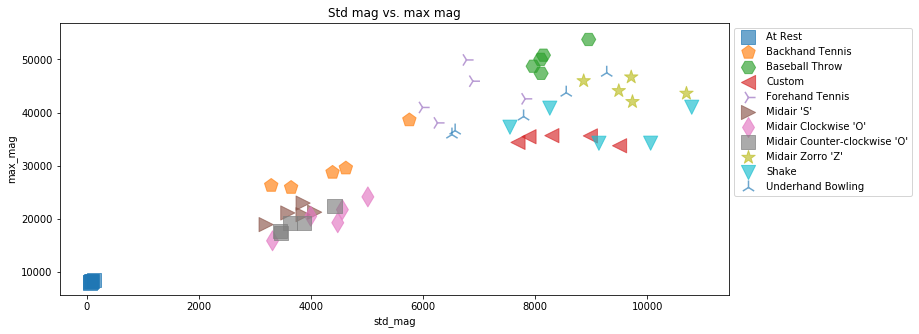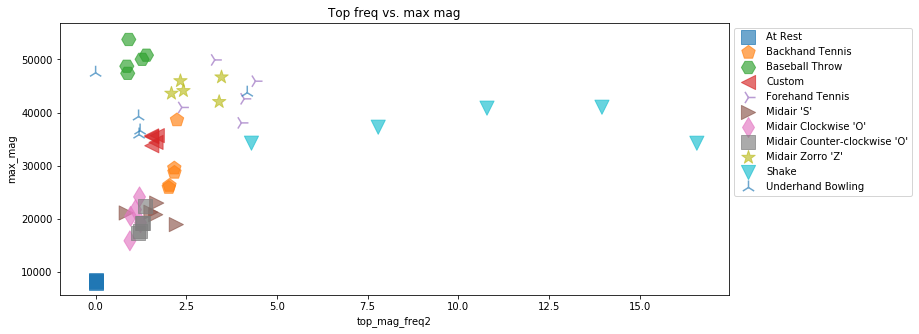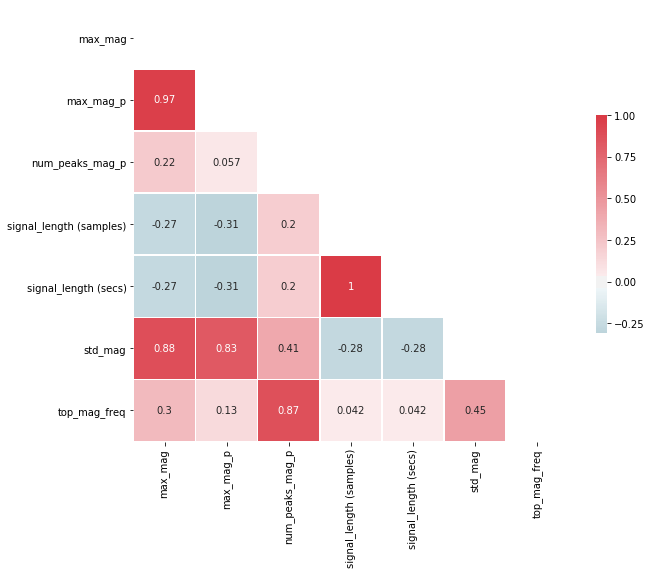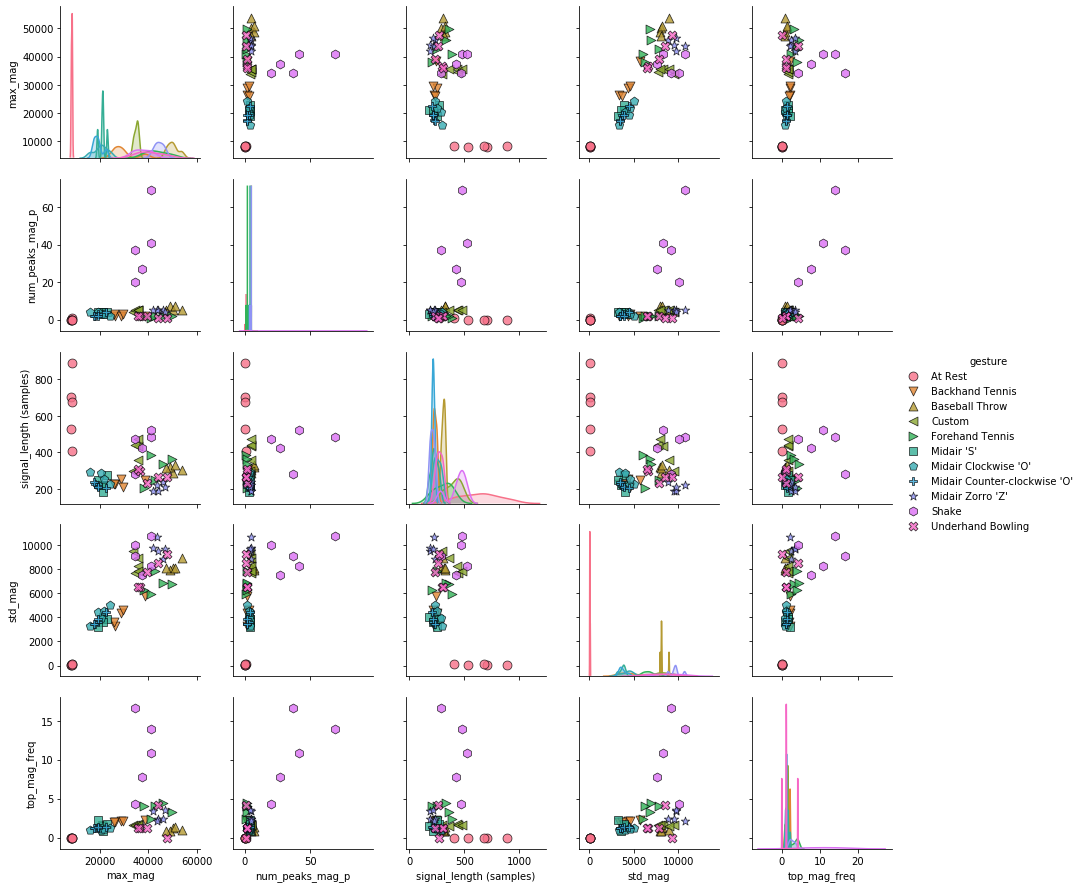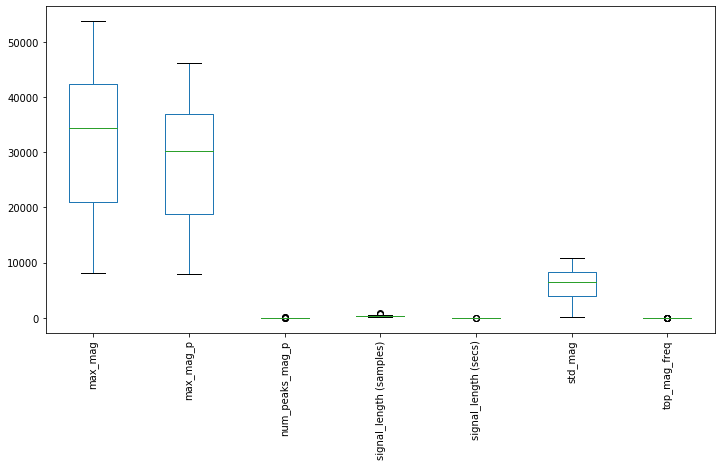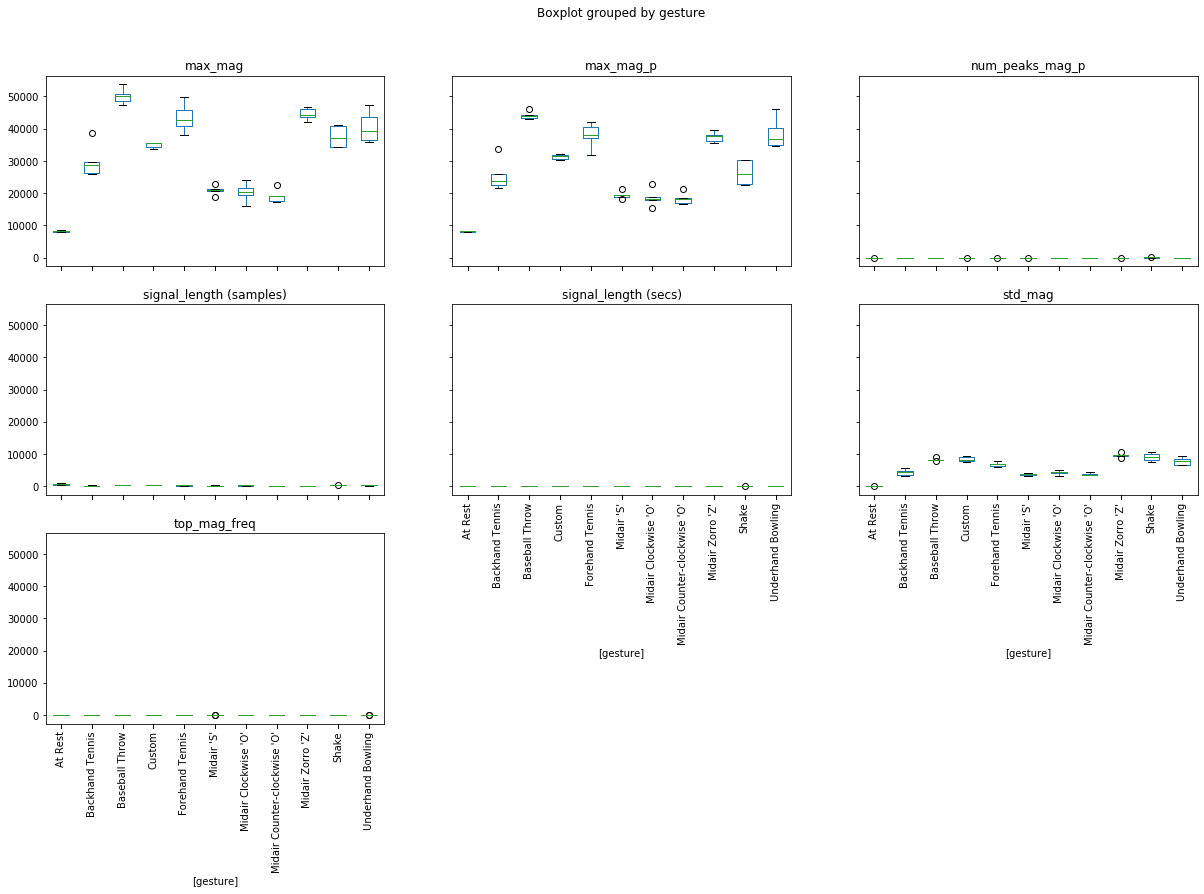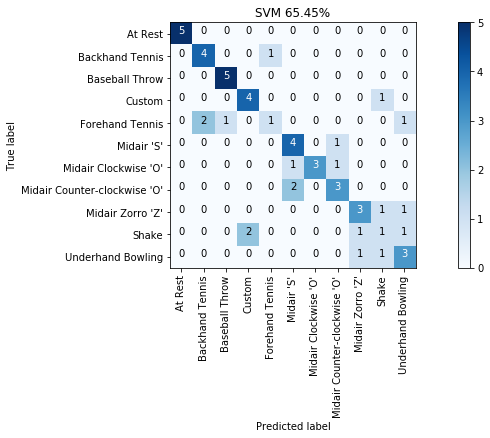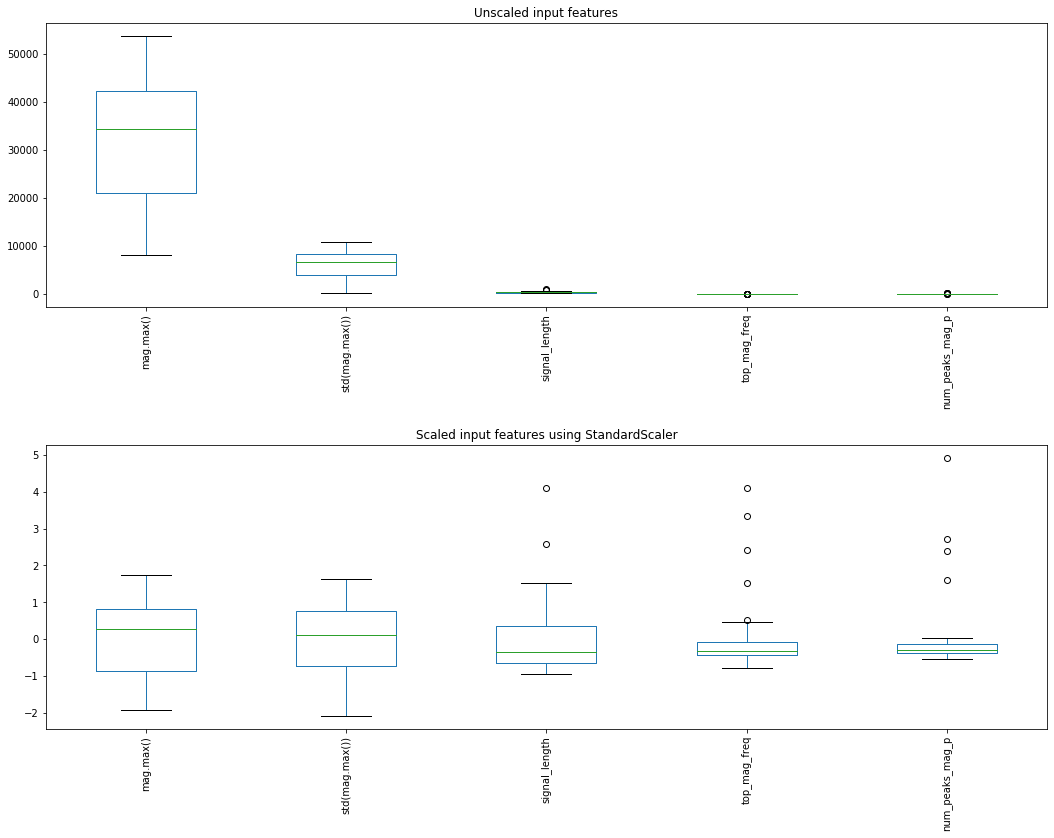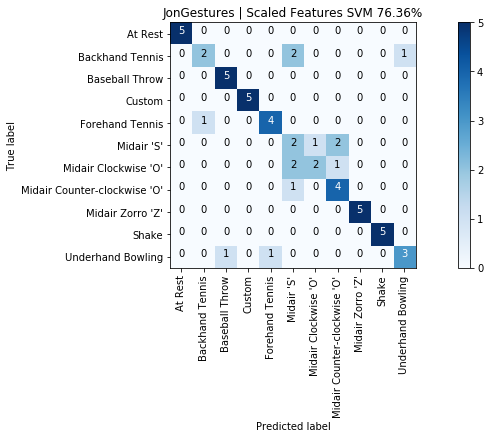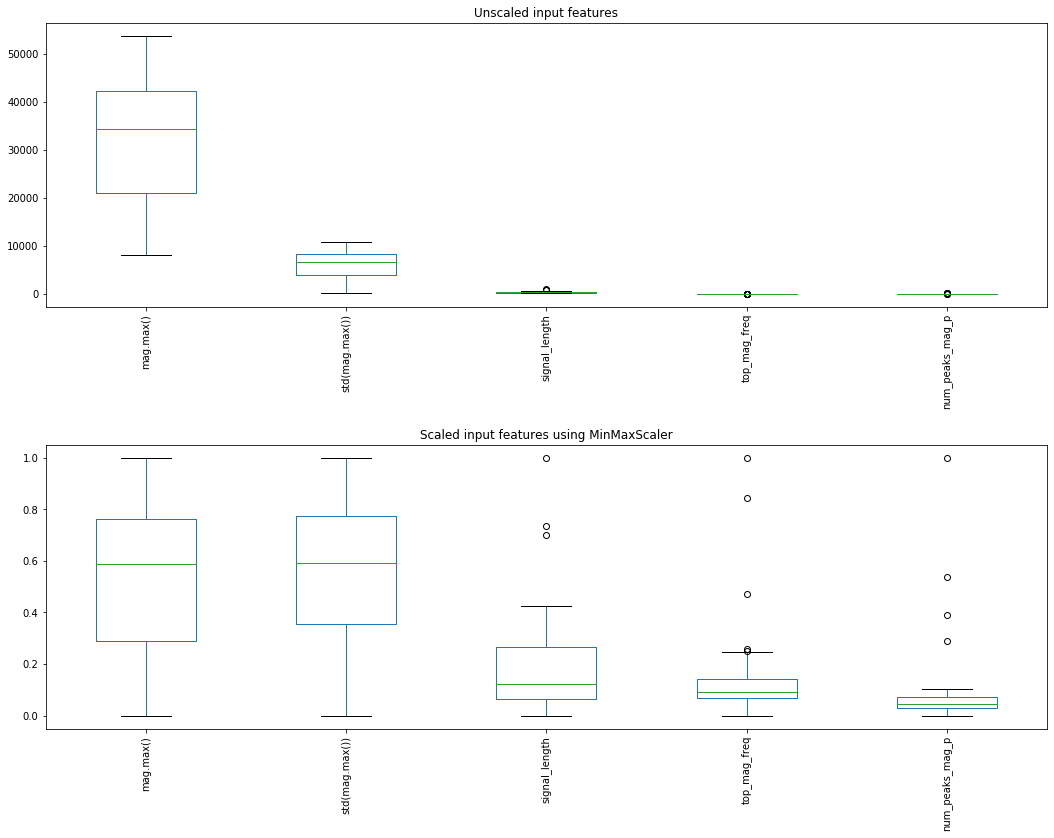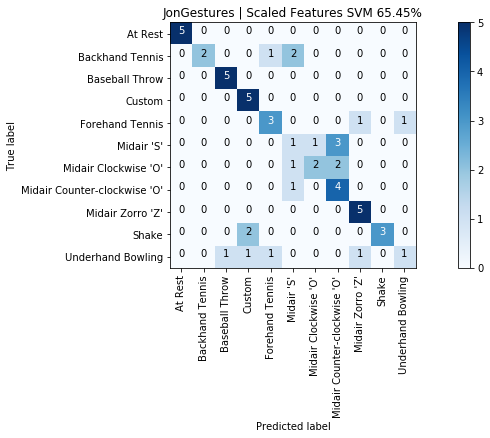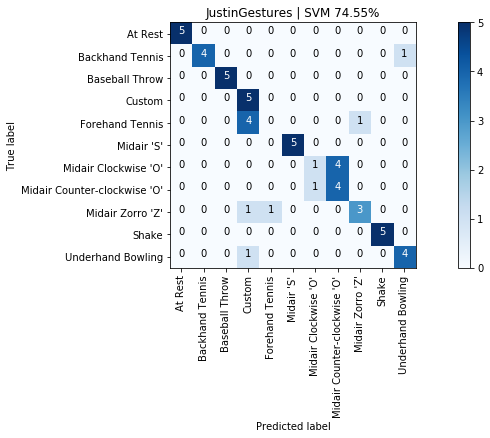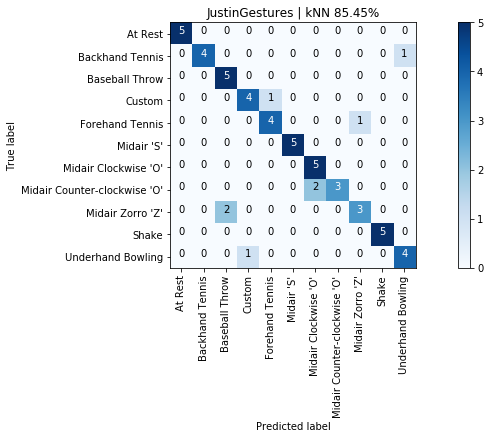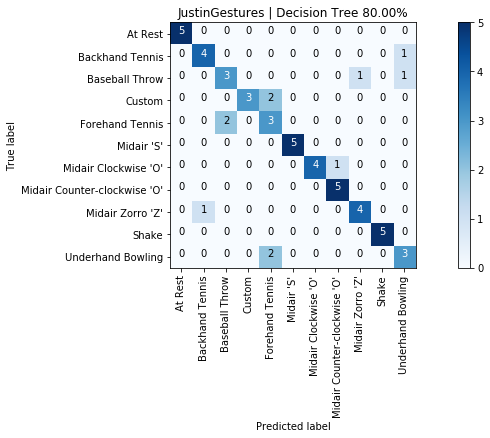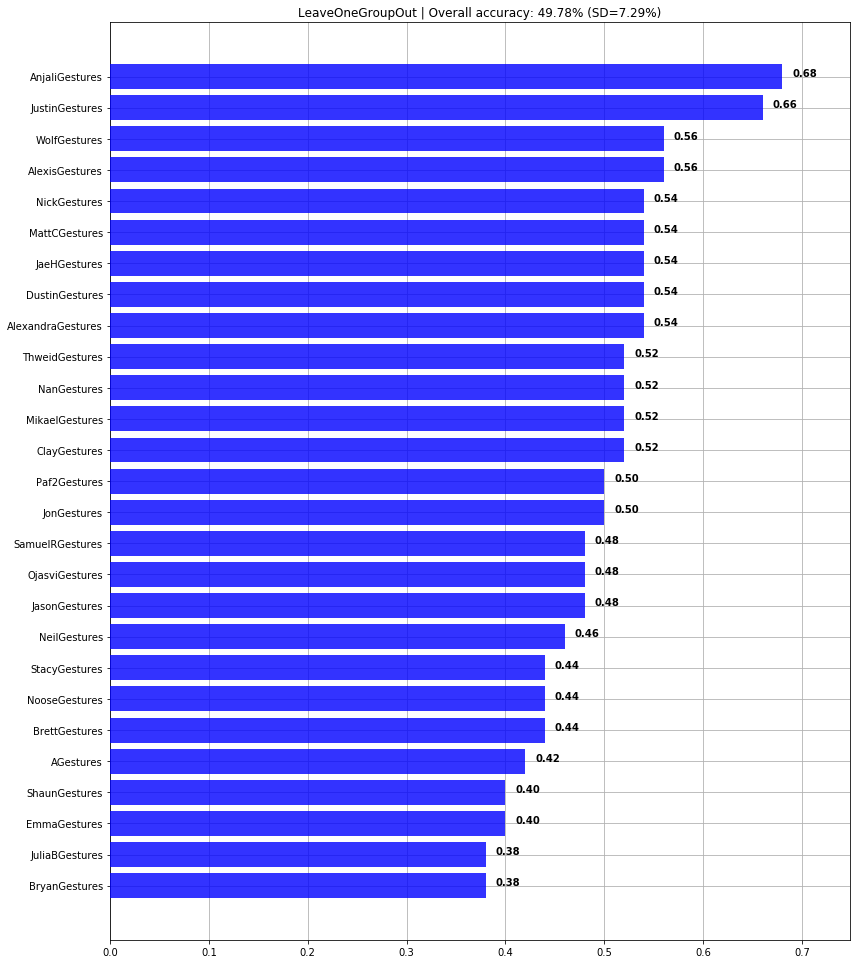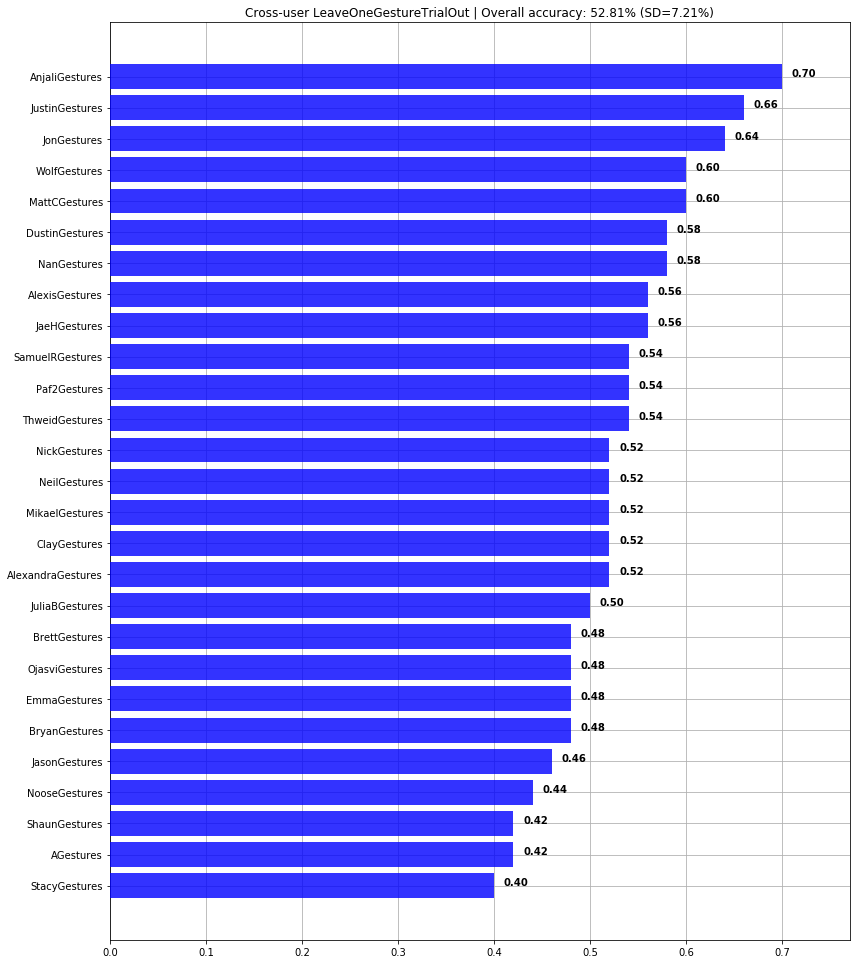Overview¶
In this Notebook, we are going to setup the framework for using a feature-based, supervised learning model to classify our gesture sets. While in the last assignment you built up familiarity with the SciPy libraries and an initial understanding of shape-based gesture classification, in this Notebook you will begin to learn:
- How to use Scikit-learn, one of the most popular open-source machine learning libraries in the world
- How to rethink the classification problem not just in terms of signal shapes (as before) but in terms of signal features. You will brainstorm, visualize, and analyze both time-domain and frequency-domain features extracted from the gesture accelerometer data and learn how to find and then use potentially promising features in your classifier
- How to setup a classification experiment using Scikit-learn (you don't have to rely on your own k-fold cross validation code, for example)
- How to use some of the built-in supervised learning models in Scikit-learn to classify gestures
Scikit learn¶
We are going to shift from using our own classifiers and experimental testbed (say goodbye to our custom gesturerec.experiments library) to a popular open-source machine learning library called Scikit-learn (code repo). Scikit-learn (or sometimes called sklearn) started as a Google Summer of Code project and its name "SciKit" stems from using the SciPy libraries as its foundation (though its development was and is independent).
We chose Scikit-learn as our primary machine learing library because:
- It is built on NumPy, SciPy, and matplotlib (so you need not learn another set of Python libraries)
- It is one of the most popular machine learning libraries in the world. On GitHub, for example, it has 25k+ commits and 40.8k stars (link). Building familiarity and comfort with Scikit-learn will not only increase your understanding of applied machine learning but also allow you to more easily use other machine learning toolkits in the future (e.g., PyTorch, TensorFlow).
While this Notebook will cover some initial, core introductory concepts of using Scikit-learn—particularly for a gesture dataset—we are only scratching the surface of possibilities. You may want to consult the official Scikit-learn tutorials either before or after working through this Notebook. Because of Scikit's popularity, there are also numerous (wonderful) tutorials online.
Your TODOs¶
As before, you should use this Notebook as your template for the A4 assignment. We expect that you will read through and interact with cells sequentially. To help guide where you need to work, we've added "TODOs"—so search for that word. :)
Resources¶
- Scikit-learn tutorials, Scikit-learn
- Introduction to Machine Learning with Python, Andreas C. Müller & Sarah Guido, Oct 2016
About this notebook¶
This Notebook was designed and written by Professor Jon E. Froehlich at the University of Washington along with feedback from students. It is made available freely online as an open educational resource at the teaching website: https://makeabilitylab.github.io/physcomp/.
The website, Notebook code, and Arduino code are all open source using the MIT license.
Please file a GitHub Issue or Pull Request for changes/comments or email me directly.
Imports¶
# This cell includes the major classes used in our classification analyses
import matplotlib.pyplot as plt
from mpl_toolkits.mplot3d import Axes3D # for 3D plotting, woohoo!
import numpy as np
import scipy as sp
from scipy import signal
import random
import os
import math
import itertools
from IPython.display import display_html
# We wrote this gesturerec package for the class
# It provides some useful data structures for the accelerometer signal
# and running experiments so you can focus on writing classification code,
# evaluating your solutions, and iterating
import gesturerec.utility as grutils
import gesturerec.data as grdata
import gesturerec.vis as grvis
from gesturerec.data import SensorData
from gesturerec.data import GestureSet
# Scikit-learn stuff
from sklearn import svm
from sklearn.preprocessing import StandardScaler, MinMaxScaler
from sklearn.pipeline import Pipeline
from sklearn.metrics import classification_report, accuracy_score, confusion_matrix
from sklearn.model_selection import cross_val_score, cross_validate, cross_val_predict, StratifiedKFold
# Import Pandas: https://pandas.pydata.org/
import pandas as pd
# Import Seaborn: https://seaborn.pydata.org/
import seaborn as sns
Utility functions¶
def display_tables_side_by_side(df1, df2, n = None, df1_caption = "Caption table 1", df2_caption = "Caption table 2"):
'''Displays the two tables side-by-side'''
if n is not None:
df1 = df1.head(n)
df2 = df2.head(n)
# Solution from https://stackoverflow.com/a/50899244
df1_styler = df1.style.set_table_attributes("style='display:inline; margin:10px'").set_caption(df1_caption)
df2_styler = df2.style.set_table_attributes("style='display:inline'").set_caption(df2_caption)
display_html(df1_styler._repr_html_()+df2_styler._repr_html_(), raw=True)
def print_folds(cross_validator, X, y_true, trial_indices):
'''Prints out the k-fold splits'''
fold_cnt = 0
for train_index, test_index in cross_validator.split(X, y_true):
X_train, X_test = X.iloc[train_index], X.iloc[test_index]
y_train, y_test = y_true.iloc[train_index], y_true.iloc[test_index]
print("TEST FOLD {}".format(fold_cnt))
for i in test_index:
print("\t{} {}".format(y_true[i], trial_indices[i]))
fold_cnt += 1
def display_folds(cross_validator, X, y_true, trial_indices):
map_fold_to_class_labels = dict()
fold_cnt = 0
for train_index, test_index in cross_validator.split(X, y_true):
X_train, X_test = X.iloc[train_index], X.iloc[test_index]
y_train, y_test = y_true.iloc[train_index], y_true.iloc[test_index]
class_labels = []
for i in test_index:
class_labels.append(f"{y_true[i]} {trial_indices[i]}")
map_fold_to_class_labels[f"Fold {fold_cnt}"] = class_labels
fold_cnt += 1
df = pd.DataFrame(map_fold_to_class_labels)
display(df)
def compute_fft(s, sampling_rate, n = None, scale_amplitudes = True):
'''Computes an FFT on signal s using numpy.fft.fft.
Parameters:
s (np.array): the signal
sampling_rate (num): sampling rate
n (integer): If n is smaller than the length of the input, the input is cropped. If n is
larger, the input is padded with zeros. If n is not given, the length of the input signal
is used (i.e., len(s))
scale_amplitudes (boolean): If true, the spectrum amplitudes are scaled by 2/len(s)
'''
if n == None:
n = len(s)
fft_result = np.fft.fft(s, n)
num_freq_bins = len(fft_result)
fft_freqs = np.fft.fftfreq(num_freq_bins, d = 1 / sampling_rate)
half_freq_bins = num_freq_bins // 2
fft_freqs = fft_freqs[:half_freq_bins]
fft_result = fft_result[:half_freq_bins]
fft_amplitudes = np.abs(fft_result)
if scale_amplitudes is True:
fft_amplitudes = 2 * fft_amplitudes / (len(s))
return (fft_freqs, fft_amplitudes)
def get_top_n_frequency_peaks(n, freqs, amplitudes, min_amplitude_threshold = None):
''' Finds the top N frequencies and returns a sorted list of tuples (freq, amplitudes) '''
# Use SciPy signal.find_peaks to find the frequency peaks
# JonTODO: in future, could add in support for min horizontal distance so we don't find peaks close together
# SciPy's find_peaks supports this, so would be straightforward to implement
fft_peaks_indices, fft_peaks_props = sp.signal.find_peaks(amplitudes, height = min_amplitude_threshold)
freqs_at_peaks = freqs[fft_peaks_indices]
amplitudes_at_peaks = amplitudes[fft_peaks_indices]
if n < len(amplitudes_at_peaks):
ind = np.argpartition(amplitudes_at_peaks, -n)[-n:] # from https://stackoverflow.com/a/23734295
ind_sorted_by_coef = ind[np.argsort(-amplitudes_at_peaks[ind])] # reverse sort indices
else:
ind_sorted_by_coef = np.argsort(-amplitudes_at_peaks)
return_list = list(zip(freqs_at_peaks[ind_sorted_by_coef], amplitudes_at_peaks[ind_sorted_by_coef]))
return return_list
map_marker_to_desc = {
".":"point",
",":"pixel",
"o":"circle",
"v":"triangle_down",
"^":"triangle_up",
"<":"triangle_left",
">":"triangle_right",
"1":"tri_down",
"2":"tri_up",
"3":"tri_left",
"4":"tri_right",
"8":"octagon",
"s":"square",
"p":"pentagon",
"*":"star",
"h":"hexagon1",
"H":"hexagon2",
"+":"plus",
"D":"diamond",
"d":"thin_diamond",
"|":"vline",
"_":"hline"
}
plot_markers = ['o','v','^','<','>','s','p','P','*','h','X','D','d','|','_',0,1,2,3,4,5,6,7,8,9,10,'1','2','3','4',',']
def plot_feature_1d(gesture_set, extract_feature_func, title = None, use_random_y_jitter = True,
xlim = None):
'''
Plots the extracted feature on a 1-dimensional plot. We use a random y-jitter
to make the values more noticeable
Parameters:
gesture_set: the GestureSet class
extract_feature_func: a "pointer" to a function that accepts a trial.accel object and returns an extracted feature
title: the graph title
use_random_y_jitter: provides a random y jitter to make it easier to see values
xlim: set the x range of the graph
'''
markers = list(map_marker_to_desc.keys())
random.Random(3).shuffle(markers)
marker = itertools.cycle(markers)
plt.figure(figsize=(12, 3))
for gesture_name in selected_gesture_set.get_gesture_names_sorted():
trials = selected_gesture_set.map_gestures_to_trials[gesture_name]
x = list(extract_feature_func(trial.accel) for trial in trials)
y = None
if use_random_y_jitter:
y = np.random.rand(len(x))
else:
y = np.zeros(len(x))
marker_sizes = [200] * len(x) # make the marker sizes larger
plt.scatter(x, y, alpha=0.65, marker=next(marker),
s = marker_sizes, label=gesture_name)
plt.ylim((0,3))
if xlim is not None:
plt.xlim(xlim)
if use_random_y_jitter:
plt.ylabel("Ignore the y-axis")
plt.legend(bbox_to_anchor=(1,1))
if title is None:
title = f"1D plot of {extract_feature_func.__name__}"
plt.title(title)
plt.show()
def plot_feature_2d(gesture_set, extract_feature_func1, extract_feature_func2,
xlabel = "Feature 1", ylabel = "Feature 2",
title = None, xlim = None):
'''
Plots the two extracted features on a 2-dimensional plot.
Parameters:
gesture_set: the GestureSet class
extract_feature_func1: a "pointer" to a function that accepts a trial.accel object and returns an extracted feature
extract_feature_func2: a "pointer" to a function that accepts a trial.accel object and returns an extracted feature
title: the graph title
xlim: set the x range of the graph
'''
markers = list(map_marker_to_desc.keys())
random.Random(3).shuffle(markers)
marker = itertools.cycle(markers)
plt.figure(figsize=(12, 5))
for gesture_name in selected_gesture_set.get_gesture_names_sorted():
trials = selected_gesture_set.map_gestures_to_trials[gesture_name]
x = list(extract_feature_func1(trial.accel) for trial in trials)
y = list(extract_feature_func2(trial.accel) for trial in trials)
marker_sizes = [200] * len(x) # make the marker sizes larger
plt.scatter(x, y, alpha=0.65, marker=next(marker),
s = marker_sizes, label=gesture_name)
plt.xlabel(xlabel)
plt.ylabel(ylabel)
if xlim is not None:
plt.xlim(xlim)
plt.legend(bbox_to_anchor=(1,1))
plt.title(title)
plt.show()
def plot_feature_3d(gesture_set, extract_feature_func1, extract_feature_func2,
extract_feature_func3, xlabel = "Feature 1", ylabel = "Feature 2",
zlabel = "Feature 2", title = None, figsize=(12,9)):
'''
Plots the two extracted features on a 2-dimensional plot.
Parameters:
gesture_set: the GestureSet class
extract_feature_func1: a "pointer" to a function that accepts a trial.accel object and returns an extracted feature
extract_feature_func2: a "pointer" to a function that accepts a trial.accel object and returns an extracted feature
extract_feature_func3: a "pointer" to a function that accepts a trial.accel object and returns an extracted feature
title: the graph title
xlim: set the x range of the graph
'''
markers = list(map_marker_to_desc.keys())
random.Random(3).shuffle(markers)
marker = itertools.cycle(markers)
fig = plt.figure(figsize=figsize)
ax = Axes3D(fig)
for gesture_name in selected_gesture_set.get_gesture_names_sorted():
trials = selected_gesture_set.map_gestures_to_trials[gesture_name]
x = list(extract_feature_func1(trial.accel) for trial in trials)
y = list(extract_feature_func2(trial.accel) for trial in trials)
z = list(extract_feature_func2(trial.accel) for trial in trials)
marker_sizes = [200] * len(x) # make the marker sizes larger
ax.scatter(x, y, z, alpha=0.65, marker=next(marker),
s = marker_sizes, label=gesture_name)
ax.set_xlabel(xlabel)
ax.set_ylabel(ylabel)
ax.set_zlabel(zlabel)
ax.legend()
ax.set_title(title)
return fig, ax
def plot_bar_graph(d, title=None, ylabel=None, xlabel=None):
'''
Plots a bar graph of of the values in d (with the keys as names)
'''
sorted_tuple_list = sorted(d.items(), key=lambda x: x[1])
n_groups = len(d)
sorted_keys = []
sorted_values = []
for k, v in sorted_tuple_list:
sorted_keys.append(k)
sorted_values.append(v)
# create plot
fig_height = max(n_groups * 0.5, 5)
plt.figure(figsize=(12, fig_height))
indices = np.arange(len(sorted_keys))
plt.grid(zorder=0)
bars = plt.barh(indices, sorted_values, alpha=0.8, color='b', zorder=3)
plt.ylabel(xlabel)
plt.xlabel(ylabel)
plt.xlim(0, sorted_values[-1] * 1.1)
plt.title(title)
plt.yticks(indices, sorted_keys)
for i, v in enumerate(sorted_values):
plt.text(v + 0.01, i, "{:0.2f}".format(v), color='black', fontweight='bold')
plt.tight_layout()
plt.show()
def plot_signals(gesture_set, signal_var_names = ['x', 'y', 'z']):
'''Plots the gesture set as a grid given the signal_var_names'''
num_rows = len(gesture_set.map_gestures_to_trials)
num_cols = len(signal_var_names)
row_height = 3.5
fig, axes = plt.subplots(num_rows, num_cols, figsize=(15, row_height * num_rows))
fig.subplots_adjust(hspace=0.5)
index = 0
for row, gesture_name in enumerate(gesture_set.get_gesture_names_sorted()):
gesture_trials = gesture_set.get_trials_for_gesture(gesture_name)
for trial in gesture_trials:
for col, signal_var_name in enumerate(signal_var_names):
s = getattr(trial.accel, signal_var_name)
axes[row][col].plot(s, alpha=0.7, label=f"Trial {trial.trial_num}")
axes[row][col].set_title(f"{gesture_name}: {signal_var_name}")
axes[row][col].legend()
fig.tight_layout(pad=2)
def plot_signals_aligned(gesture_set, signal_var_names = ['x', 'y', 'z'], title_fontsize=8):
'''Aligns each signal using cross correlation and then plots them'''
num_rows = len(gesture_set.map_gestures_to_trials)
num_cols = len(signal_var_names)
row_height = 3.5
fig, axes = plt.subplots(num_rows, num_cols, figsize=(15, row_height * num_rows))
fig.subplots_adjust(hspace=0.5)
index = 0
for row, gesture_name in enumerate(gesture_set.get_gesture_names_sorted()):
gesture_trials = gesture_set.get_trials_for_gesture(gesture_name)
for col, signal_var_name in enumerate(signal_var_names):
# Find the maximum length signal. We need this to pad all
# signals to the same length (a requirement of cross correlation)
signal_lengths = []
for trial in gesture_trials:
s = getattr(trial.accel, signal_var_name)
signal_lengths.append(len(s))
max_trial_length = np.max(signal_lengths)
# Actually pad the signals
signals = []
for trial in gesture_trials:
s = getattr(trial.accel, signal_var_name)
padding_length = max_trial_length - len(s)
if padding_length > 0:
pad_amount_left = (math.floor(padding_length/2.0))
pad_amount_right = (math.ceil(padding_length/2.0))
padded_s = np.pad(s, (pad_amount_left, pad_amount_right), mode = 'mean')
signals.append(padded_s)
else:
signals.append(s)
# Grab a signal to align everything to. We could more carefully choose
# this signal to be the closest signal to the average aggregate... but this
# should do for now
golden_signal = signals[0] # the signal to align everything to
# Align all the signals and store them in aligned_signals
aligned_signals = [golden_signal]
for i in range(1, len(signals)):
a = golden_signal
b = signals[i]
correlate_result = np.correlate(a, b, 'full')
best_correlation_index = np.argmax(correlate_result)
shift_amount = (-len(a) + 1) + best_correlation_index
b_shifted_mean_fill = shift_array(b, shift_amount, np.mean(b))
aligned_signals.append(b_shifted_mean_fill)
# Plot the aligned signals
for signal_index, trial in enumerate(gesture_trials):
s = aligned_signals[signal_index]
axes[row][col].plot(s, alpha=0.7, label=f"Trial {trial.trial_num}")
axes[row][col].set_title(f"Aligned {gesture_name}: {signal_var_name}", fontsize=title_fontsize)
axes[row][col].legend()
fig.tight_layout(pad=2)
def shift_array(arr, shift_amount, fill_value = np.nan):
'''Shifts the array either left or right by the shift_amount (which can be negative or positive)
From: https://stackoverflow.com/a/42642326
'''
result = np.empty_like(arr)
if shift_amount > 0:
result[:shift_amount] = fill_value
result[shift_amount:] = arr[:-shift_amount]
elif shift_amount < 0:
result[shift_amount:] = fill_value
result[:shift_amount] = arr[-shift_amount:]
else:
result[:] = arr
return result
Load the data¶
These cells are the same as for the Shape Matching notebook. You should not need to edit them, only run them.
# Load the data
#root_gesture_log_path = './GestureLogsADXL335'
root_gesture_log_path = './GestureLogs'
print("Found the following gesture log sub-directories")
print(grutils.get_immediate_subdirectories(root_gesture_log_path))
gesture_log_paths = grutils.get_immediate_subdirectories(root_gesture_log_path)
map_gesture_sets = dict()
selected_gesture_set = None
for gesture_log_path in gesture_log_paths:
path_to_gesture_log = os.path.join(root_gesture_log_path, gesture_log_path)
print("Creating a GestureSet object for path '{}'".format(path_to_gesture_log))
gesture_set = GestureSet(path_to_gesture_log)
gesture_set.load()
map_gesture_sets[gesture_set.name] = gesture_set
if selected_gesture_set is None:
# Since we load multiple gesture sets and often want to just visualize and explore
# one set, in particular, we set a selected_gesture_set variable here
# Feel free to change this
#selected_gesture_set = get_random_gesture_set(map_gesture_sets)
selected_gesture_set = grdata.get_gesture_set_with_str(map_gesture_sets, "Jon")
if selected_gesture_set is None:
# if the selected gesture set is still None
selected_gesture_set = grdata.get_random_gesture_set(map_gesture_sets);
print("The selected gesture set:", selected_gesture_set)
The map_gesture_sets is a dict object and is our primary data structure: it maps gesture dir names to GestureSet objects. There's truly nothing special here. But we realize our data structures do require a learning ramp-up. Let's iterate through the GestureSets.
print(f"We have {len(map_gesture_sets)} gesture sets:")
for gesture_set_name, gesture_set in map_gesture_sets.items():
print(f" {gesture_set_name} with {len(gesture_set.get_all_trials())} trials")
# Feel free to change the selected_gesture_set. It's just a convenient variable
# to explore one gesture set at a time
print(f"The selected gesture set is: {selected_gesture_set.name}")
Preprocess the data¶
You may or may not want to revisit how you preprocess your data. Remember: we are using a fundamentally different approach for classification, so it's worth reconsidering your full data analysis pipeline.
def preprocess_signal(s):
'''Preprocesses the signal'''
# TODO: write your preprocessing code here. We'll do something very simple for now,
mean_filter_window_size = 10
processed_signal = np.convolve(s,
np.ones((mean_filter_window_size,))/mean_filter_window_size,
mode='valid')
return processed_signal
def preprocess_trial(trial):
'''Processess the given trial'''
trial.accel.x_p = preprocess_signal(trial.accel.x)
trial.accel.y_p = preprocess_signal(trial.accel.y)
trial.accel.z_p = preprocess_signal(trial.accel.z)
trial.accel.mag_p = preprocess_signal(trial.accel.mag)
for gesture_set in map_gesture_sets.values():
for gesture_name, trials in gesture_set.map_gestures_to_trials.items():
for trial in trials:
preprocess_trial(trial)
Feature exploration¶
We are going to start this adventure, as we always should, by trying to better understand our signals and the features we plan to extract.
Our goal is to brainstorm and identify highly discriminable attributes of each gesture class that we may be able to leverage in our feature-based classifiers.
While our classifiers will work in high-dimensions, humans, at best can really only visualize and interpret at most 3-dimensions.
So, we're going to start by graphing our features along 1-dimension. Yes, 1-dimension! To make it easier to see patterns in our data, we will add in a bit of y-jitter, so the graphs below may appear 2-dimensional—but they are not. Ignore the y-axis for these 1D plots.
Time domain¶
Let's explore some time domain features first.
Visualizing time-domain signals¶
Just like with shape-matching, let's begin by graphing the time-domain signals.
Visualizing raw x, y, z, and mag¶
plot_signals(selected_gesture_set, ['x', 'y', 'z', 'mag'])
Visualizing aligned raw signals¶
It may be easier to pick out interesting patterns with the signals aligned.
plot_signals_aligned(selected_gesture_set, ['x', 'y', 'z', 'mag'])
Visualizing processed x, y, z, and mag signals¶
Now let's visualize the processed signals.
plot_signals(selected_gesture_set, ['x_p', 'y_p', 'z_p', 'mag_p'])
Visualizing aligned processed signals¶
plot_signals_aligned(selected_gesture_set, ['x_p', 'y_p', 'z_p', 'mag_p'])
Extract and visualize time-domain features¶
After reviewing the above graphs and thinking about what features we might be able to extract from the time-domain signals, let's extract and plot some specific time-domain features. We've created a helper function called plot_feature_1d, which will plot a specified feature in a 1-dimensional graph.
Let's check it out!
Feature: standard deviation of accel mag¶
# Write a simple anonymous function that takes in an accel.trial and returns
# an extracted feature. In this case, the standard deviation of the magnitude
extract_feature_std_mag = lambda accel_trial: np.std(accel_trial.mag)
# We could also have done the following but it's slightly messier for our purposes
# def extract_feature_std_mag(accel_trial):
# return np.std(accel_trial.mag)
# Plot the feature (but with no y-jitter)
graph_title = "1D plot of the standard deviation of the accel mag"
plot_feature_1d(selected_gesture_set, extract_feature_std_mag,
title = graph_title, use_random_y_jitter = False)
To make it easier to see the 1-dimensional spacing, by default, we add in a random y-jitter (which is a common graphing trick). But just remember, the y-values here are meaningless. We'll make real 2-dimensional plots a bit further down.
So, let's graph the same thing but with the random y jitter turned on.
graph_title = "1D plot of the standard deviation of the accel mag"
plot_feature_1d(selected_gesture_set, extract_feature_std_mag, title = graph_title)
Even with just one feature and a 1D plot, we can begin to see some separation between gestures:
- Unsurprisingly, the At Rest gesture has the least amount of deviation
- And then there are ~2 or maybe 3 other groups: a middle group of Clockwise 'O', Counter-clockwise 'O', Backhand Tennis, a less defined intermediate group of Forehand Tennis and Underhand Bowling, and a more extreme group of Shake, Midair Zorro 'Z', and Baseball Throw
Feature: maximum accel mag¶
How about the maximum of the accelerometer magnitude in each gesture trial? Is there discriminable information there?
Let's check it out!
extract_feature_max_mag = lambda accel_trial: np.max(accel_trial.mag)
plot_feature_1d(selected_gesture_set, extract_feature_max_mag,
title = "1D plot of the max accel mag")
What do you observe? Again, this feature seems useful—at least for discriminating some gestures like At Rest and Baseball Throw. As before, there are also clear clusters that are emerging.
Feature: num peaks¶
Finally, let's count the number of peaks (given a certain height and distance threshold). Unlike our other input features thus far, count data is discrete (not continuous), is limited to non-negative values, and will have a different distribution.
def extract_feature_num_peaks_mag_p(accel_trial):
mag_p = sp.signal.detrend(accel_trial.mag_p)
# height is the height of the peaks and distance is the minimum horizontal distance
# (in samples) between peaks. Feel free to play with these thresholds
peak_indices, peak_properties = sp.signal.find_peaks(mag_p, height=100, distance=5)
return len(peak_indices)
plot_feature_1d(selected_gesture_set, extract_feature_num_peaks_mag_p,
title = "1D plot of the num of peaks in mag_p")
Brainstorm and plot your own time domain features¶
Below, brainstorm and plot your own time domain features. We've provided an initial list of features to try but dig into the signals, think about what makes each gesture class unique, and try to extract and leverage those unique aspects as features.
You could extract (many of) these features either from the raw accelerometer signal (e.g., x, y, z, and mag) or a preprocessed version.
- Signal length
- Descriptive statistics of each axis (x, y, z) + magnitude, including mean, median, standard deviation
- Peak counting (raw number of peaks, number of peaks over certain threshold)
- Horizontal distance between peaks, avg vertical distance between peaks
- Number of zero crossings
- Other things! Read papers, brainstorm, visualize!
Once you've exhausted our list and your own mind, consult the web. Use Google Scholar, for example, to find gesture recognition papers: what features did they use?
# We'll start with another one here: signal length but add more!
extract_feature_signal_length = lambda accel_trial: len(accel_trial.x)
plot_feature_1d(selected_gesture_set, extract_feature_signal_length,
title = "1D plot of the signal length")
Frequency domain¶
Of course, there may also be discriminable information in the frequency domain. If you haven't already, complete our Frequency Analysis lesson before moving forward.
Just as we brainstormed time domain features, how about features in the frequency domain, such as:
- The top frequency (i.e., the frequency with the highest amplitude in the signal)
- The top N frequencies (overall or within some frequency band)
- The lowest/highest frequency (over some amplitude threshold)
- Number of frequency peaks (over a certain amplitude threshold)
- Avg value of frequency peaks
- Or perhaps a sliding window that breaks up the signal into chunks and extracts frequency information over each chunk
- And many others...
Visualizing frequency information¶
Let's start—as we always should—by plotting our signals and exploring some initial stats.
Below, we plot a visualization grid where each column is a gesture trial and rows alternate between the time domain and frequency domain versions of the mag for that gesture.
# This cell will take a bit of time not because of the frequency analysis but because
# of preparing the large matplotlib image
import IPython.display as ipd
import ipywidgets
num_cols = 5 # 1 col for each gesture trial
num_rows = selected_gesture_set.get_num_gestures() * 2 # 1 for waveform, 1 for frequency per gesture
row_height = 3
fig, axes = plt.subplots(num_rows, num_cols, figsize=(15, row_height * num_rows))
index = 0
sampling_rate = 92 # roughly 92
progress_bar = ipywidgets.IntProgress(value=0, min=0, max=num_rows)
ipd.display(progress_bar)
title_font_size = 8
for gesture_name in selected_gesture_set.get_gesture_names_sorted():
gesture_trials = selected_gesture_set.get_trials_for_gesture(gesture_name)
for trial in gesture_trials:
s = trial.accel.mag_p # change this to visualize/explore other signals
ax = axes[index][trial.trial_num]
# remove "DC offset" to perform FFT
s_removed_offset = s - np.mean(s)
ax.plot(s_removed_offset, alpha=0.7, label=f"Trial {trial.trial_num}")
ax.set_title(f"{gesture_name[0:12]} waveform", fontsize= title_font_size)
ax.legend()
sampling_rate = math.ceil(trial.accel.sampling_rate)
ax = axes[index + 1][trial.trial_num]
spectrum, freqs_of_spectrum, line = ax.magnitude_spectrum(s_removed_offset, Fs = sampling_rate,
color='r', pad_to = 4 * len(s))
ax.set_title(f"{gesture_name[0:12]} freq spectrum", fontsize= title_font_size)
# Annotate the top freq (by amplitude) on each graph
top_n_freq_with_amplitudes = get_top_n_frequency_peaks(1, freqs_of_spectrum, spectrum)
top_freq = top_n_freq_with_amplitudes[0][0]
top_amplitude = top_n_freq_with_amplitudes[0][1]
ax.plot(top_freq, top_amplitude, marker="x", color="black", alpha=0.8)
ax.text(top_freq, top_amplitude, f"{top_freq:0.1f} Hz", color="black")
index = index + 2
progress_bar.value = index
fig.tight_layout(pad=1)
print(f"Selected gesture set: {selected_gesture_set.name}")
Feature: top frequency¶
As one example, let's extract the most prominent (highest-amplitude) frequency for each gesture using the magnitude part of the accelerometer signal.
def extract_feature_top_mag_freq(accel_trial):
sampling_rate = math.ceil(accel_trial.sampling_rate)
(fft_freqs, fft_amplitudes) = compute_fft(accel_trial.mag, sampling_rate)
top_n_freq_with_amplitudes = get_top_n_frequency_peaks(1, fft_freqs, fft_amplitudes)
if len(top_n_freq_with_amplitudes) <= 0:
return 0
return top_n_freq_with_amplitudes[0][0]
plot_feature_1d(selected_gesture_set, extract_feature_top_mag_freq,
title = "1D plot of the most prominent raw mag freq in each signal")
You might be surprised to see At Rest's position in the graph. This is because we do not take into account the strength of the frequency component for each signal. The identified frequencies in At Rest are low amplitude (and largely noise).
To control for this, we can add in a parameter to get_top_n_frequency_peaks to filter out identified frequencies of less than a certain amplitude coefficient. In this case, let's try 500 but you should experiment with any thresholds used in your code.
def extract_feature_top_mag_freq2(accel_trial):
sampling_rate = math.ceil(accel_trial.sampling_rate)
(fft_freqs, fft_amplitudes) = compute_fft(accel_trial.mag, sampling_rate)
top_n_freq_with_amplitudes = get_top_n_frequency_peaks(1, fft_freqs, fft_amplitudes, min_amplitude_threshold = 500)
if len(top_n_freq_with_amplitudes) <= 0:
return 0
return top_n_freq_with_amplitudes[0][0]
plot_feature_1d(selected_gesture_set, extract_feature_top_mag_freq2,
title = "1D plot of the most prominent raw mag freq in each signal (with min amplitude 500)")
We are able to see roughly four groupings here:
- The At Rest group
- A second cluster with frequencies between ~0.5 and 2.5 Hz
- Possibly a third cluster with Zorro and Forehand Tennis between ~2.5 and 5 Hz
- And another clear outlier cluster for Shake with freq between ~5-15 Hz
Let's zoom into the x-axis a bit to explore the middle cluster more closely.
plot_feature_1d(selected_gesture_set, extract_feature_top_mag_freq2,
title = "1D plot of the most prominent raw mag freq in each signal (with min amplitude 500)",
xlim = (0, 5))
We can, of course, perform frequency analyses on any other signal—be it x, y, z, mag or some processed version. For example, here's a frequency analysis of a preprocessed mag_p signal.
def extract_feature_top_mag_p_freq(accel_trial):
sampling_rate = math.ceil(accel_trial.sampling_rate)
(fft_freqs, fft_amplitudes) = compute_fft(accel_trial.mag_p, sampling_rate)
top_n_freq_with_amplitudes = get_top_n_frequency_peaks(1, fft_freqs, fft_amplitudes, min_amplitude_threshold = 500)
if len(top_n_freq_with_amplitudes) <= 0:
return 0
return top_n_freq_with_amplitudes[0][0]
plot_feature_1d(selected_gesture_set, extract_feature_top_mag_p_freq,
title = "1D plot of the most prominent processed mag freq in each signal")
Brainstorm and plot your own frequency domain features¶
What other features can you think of for the frequency domain?
# TODO: Graph additional frequency-based features
2-dimensional explorations¶
OK, now that we've built up some familiarity with feature extraction and how these features may enable us to discriminate gestures, let's plot various combinations of them in 2D. Again, remember that our classifiers will (often) work in N-dimensions where N is the number of features. But it's just not possible for us to visualize all of our features at once in an N-dimensional graph.
But at least we're going from 1D to 2D, wee! :)
We'll begin by just randomly choosing some features to plot together: how about the standard deviation of the accel mag and the max mag?
plot_feature_2d(selected_gesture_set, extract_feature_std_mag, extract_feature_max_mag,
xlabel="std_mag", ylabel="max_mag", title="Std mag vs. max mag")
Again, our goal here is to see clear clusters emerging—ideally where each cluster is composed of the same gesture class and the clusters themselves have clear separation.
Let's try another combination. How about the max mag frequency component (in frequency domain) and the max mag signal value (in the time domain).
# plot_feature_2d(selected_gesture_set, extract_feature_top_mag_freq2, extract_feature_std_mag,
# xlabel="extract_feature_top_mag_freq2", ylabel="max_mag", title="Std mag vs. max mag")
plot_feature_2d(selected_gesture_set, extract_feature_top_mag_freq2, extract_feature_max_mag,
xlabel="top_mag_freq2", ylabel="max_mag", title="Top freq vs. max mag")
Again, now it's up to you. Try graphing some feature combinations below. Later, we are also going to show you how to make a large number of 2-dimensional plots using something called a pairplot to explore all of our features together.
# TODO: Write some of your own 2D plot explorations
3-dimensional explorations¶
We explored 1-dimensional visualizations of our features, then 2-dimensional, can we go to 3?! Yes we can!
But that's roughly where we hit the limit of visualization dimensional space (don't worry, we'll also show you some alternative visualizations below that help us visualize lots of different feature combinations at once—though still pairwise).
And to make the 3D plots more discernible, we are going to use an IPython Magic command called %matplotlib notebook. To interact with the 3D scatter plots, you can click-and-drag to rotate and hold right mouse and move mouse up/down to zoom.
Interactive charts for the win!
Let's start by graphing the highest-amplitude frequency from the magnitude signal, the max magnitude value, and the standard deviation of magnitude for each gesture trial (grouped by gesture type).
%matplotlib notebook
plot_feature_3d(selected_gesture_set, extract_feature_top_mag_freq2,
extract_feature_max_mag, extract_feature_std_mag,
xlabel="top_mag_freq2", ylabel="max_mag", zlabel="std_mag",
title="Top freq vs. max mag vs. std mag", figsize=(10,8));
While it takes some time to familiarize oneself with a 3D visualization and pick out patterns (it helps enormously to interact with the charts by rotating and zooming), you are certainly able to see clear separation between many of the different gesture types. Shake and At Rest clearly stand out but so do Baseball Throw, Midair Zorro 'Z', Custom, and Backhand Tennis.
Let's try one more set of three input features: the number of peaks in the time domain mag_p signal along with the standard deviation and max of the mag signal.
%matplotlib notebook
plot_feature_3d(selected_gesture_set, extract_feature_std_mag,
extract_feature_max_mag, extract_feature_num_peaks_mag_p,
xlabel="top_mag_freq2", ylabel="max_mag", zlabel="std_mag",
title="Std mag vs. max mag vs. num peaks mag_p", figsize=(10,8));
Turn off interactive plots¶
Now turn of interactive plots using %matplotlib inline. You can turn back interactive plots at any time (not just for 3D plots), by executing %matplotlib notebook in a cell.
%matplotlib inline
Pandas¶
At risk of introducing too many frameworks and libraries in this course (I know!), we had to bring in one more: pandas—one of the most popular open-source data analysis tools in data science. And pandas builds on and uses SciPy libraries.
Rest assured, we are barely going to use pandas. But we are going to use pandas DataFrame data structures, which are 2-dimensional tables a bit like a spreadsheet or an SQL table. They support querying, filtering, etc. but we mainly use them because it makes interacting with Scikit-learn easier (in our humble opinions, at least).
We'll also show off a few reasons why pandas is so powerful in this sub-section.
And again, don't worry. We show you everything you need to know below. You can certainly dive deeper, if you want. Knowing pandas gives you major data science street cred. :)
While not necessary, you may want to check out the official 10-minute pandas tutorial or just dive in below.
Create pandas DataFrame of features¶
Below, we build a pandas DataFrame table of our features. This is just a small playground. The real feature extraction code that we use in our classification experiments is found below in the sub-section entitled Feature extraction code.
df = None
for gesture_name in selected_gesture_set.get_gesture_names_sorted():
trials = selected_gesture_set.map_gestures_to_trials[gesture_name]
for trial in trials:
features = dict()
features["gesturer"] = selected_gesture_set.name
features["gesture"] = gesture_name
features["trial_num"] = trial.trial_num
features["signal_length (samples)"] = extract_feature_signal_length(trial.accel)
features["signal_length (secs)"] = trial.accel.length_in_secs
features["num_peaks_mag_p"] = extract_feature_num_peaks_mag_p(trial.accel)
features["max_mag"] = extract_feature_max_mag(trial.accel)
features["max_mag_p"] = np.max(trial.accel.mag_p)
features["std_mag"] = extract_feature_std_mag(trial.accel)
features["top_mag_freq"] = extract_feature_top_mag_freq2(trial.accel)
if df is None:
df = pd.DataFrame([features])
else:
df = df.append(features, ignore_index=True)
# Calling display on a DataFrame creates a pretty HTML-formatted table!
# Print out only the first 11 rows
display(df.head(n = 11))
gesture_col = df['gesture']
display(df.groupby('gesture').describe())
Pairwise correlation¶
We can use Pandas to calculate a pairwise correlation between features. Often, we want features that have low (near zero) correlation with one another. If multiple features are highly correlated, then they will not improve our classification performance (and will also slow down training).
The function df.corr() computes a pairwise correlation of columns (by default, using a Pearson correlation, which measures the linear correlation between two variables).
For more on understanding the relationship between your input features and the Pearson correlation, read this article from Machine Learning Mastery.
# Pop a few things off the dataframe, which we don't want to include
# in our correlation analysis
if 'trial_num' in df:
df.pop("trial_num")
if 'gesture' in df:
df.pop('gesture')
if 'gesturer' in df:
df.pop('gesturer')
# Compute and show the pairwise correlation table. Again, correlations vary between
# -1 to 1 where values closest to the extremes are more strongly correlated
corr = df.corr()
display(corr)
Plot the pairwise correlation¶
Given that it's not particularly easy to find trends in a large table, we can plot this pairwise correlation table graphically and then refer back to the table for actual data.
Generally, we want to eliminate input features that are highly correlated (so close to either -1 or 1). Often, the cutoff here is 0.9 or 0.95.
From the visualization and table, we can see (unsurprisingly) that the two features signal_length (samples) and signal_length (secs) are highly correlated (indeed, exactly correlated with a correlation coefficient of 1) and that max_mag and max_mag_p are highly correlated (correlation coefficient equal to 0.97). So, one of each can be removed!
This is the type of analysis you'll want to perform with your own features. And, of course, be careful not to "overfit" to your own gesture set. Make sure to explore a variety as you're making "feature engineering" decisions.
import seaborn as sns # Seaborn is just a prettier plotting library
plt.figure(figsize=(10, 8))
sns.heatmap(corr, square=True, annot=True);
We can also plot a "prettier" version of the correlation matrix (that also takes advantage of its symmetry by only showing one side).
# Plot a "pretty" version of the correlation matrix
# Based on: https://seaborn.pydata.org/examples/many_pairwise_correlations.html
# Given that the correlation table is symmetrical, we remove one side
# Generate a mask for the upper triangle
mask = np.zeros_like(corr, dtype=np.bool)
mask[np.triu_indices_from(mask)] = True
# Set up the matplotlib figure
f, ax = plt.subplots(figsize=(10, 8))
# Generate a custom diverging colormap
cmap = sns.diverging_palette(220, 10, as_cmap=True)
# Draw the heatmap with the mask and correct aspect ratio
sns.heatmap(corr, mask=mask, cmap=cmap, vmax=1, center=0,
square=True, linewidths=.5, cbar_kws={"shrink": .5}, annot=True);
# Create correlation matrix
# Take the abs value so both negative and positive correlations are mapped from 0 to 1
corr_matrix = df.corr().abs()
# Select upper triangle of correlation matrix
upper = corr_matrix.where(np.triu(np.ones(corr_matrix.shape), k=1).astype(np.bool))
# Find index of feature columns with correlation greater than 0.95
to_drop = [column for column in upper.columns if any(upper[column] > 0.95)]
print(to_drop)
# Drop features
print(f"Dropping {len(to_drop)} features: {to_drop}")
filtered_df = df.drop(columns=to_drop)
print()
print("Remaining features:")
display(filtered_df.sample(5))
Pair plots¶
A slightly different version of the pairwise correlation grids is a pairplot, which graphs a pairwise scattplot between each variable in a cell and a univariate distribution along the diagonal. Pairplots combine our 2-dimensional explorations from before along with a pairwise correlation grid into a clean but highly information-dense visualization.
By default, just like the correlation grids above, the upper-right and lower-left (as split along the diagonal) are symmetrical. The diagonal shows a histrogram plot of the distribution of data for that variable.
For more information, see:
- Visualizing Data with Pair Plots, Towards Data Science, April 2018
- Section 1.7.3 of the Introduction to Machine Learning with Python book, Andreas C. Müller & Sarah Guido, Oct 2016
# Add the 'gesture' back into the DataFrame
filtered_df['gesture'] = gesture_col
# Create the pairplot (this might take a bit of time)
markers = plot_markers[:selected_gesture_set.get_num_gestures()]
sns.pairplot(filtered_df, hue="gesture",
plot_kws = {'alpha': 0.8, 's': 80, 'edgecolor': 'k'},
markers = markers);
Box plots¶
Finally, pandas has a built-in function, called boxplot to create a box-and-whisker plot from DataFrame columns. This enables you to explore the distribution of each feature and potential outliers.
If you're unfamiliar with these plots, as the pandas documentation explains, "a box plot is a method for graphically depicting groups of numerical data through their quartiles. The box extends from the Q1 to Q3 quartile values of the data, with a line at the median (Q2). The whiskers extend from the edges of box to show the range of the data. The position of the whiskers is set by default to $1.5 * IQR (IQR = Q3 - Q1)$ from the edges of the box. Outlier points are those past the end of the whiskers."
For more information, see the Wikipedia entry on box plots.
df.boxplot(grid=False, rot=90, fontsize=10, figsize=(12,6));
We can also graph boxplots grouped by a variable. In this case, let's group by 'gesture'.
df['gesture'] = gesture_col
df.boxplot(by='gesture', grid=False, rot=90, fontsize=10, figsize=(20, 12));
Classification¶
Whew—and to think, we haven't even made it to classification yet!
But it's important to focus on selecting good features because even the most advanced classifiers won't work without good training examples.
Below, we will walk through an entire end-to-end classification example with Scikit-learn using a selected gesture set.
Feature extraction code¶
Now that we've explored some features, you can add in some promising features to the method extract_features_from_trial, which our classifiers will use below.
This is where you spend quite a bit of time adding, subtracting, and manipulating input features for your model.
def extract_features_from_gesture_sets(gesture_sets, include_custom_gesture=True):
'''
Extracts features for all provided gesture sets.
Parameters:
gesture_sets: collection of GestureSet objects
include_custom_gesture: if True, includes the custom gesture. Otherwise, not.
'''
list_of_feature_vectors = []
column_headers = []
for gesture_set in gesture_sets:
(feature_vectors, cols) = extract_features_from_gesture_set(gesture_set, include_custom_gesture)
list_of_feature_vectors += feature_vectors
column_headers = cols
return (list_of_feature_vectors, column_headers)
def extract_features_from_gesture_set(gesture_set, include_custom_gesture=True):
'''
Extracts features from the gesture set
'''
list_of_feature_vectors = []
column_headers = None
gesture_names = None
if include_custom_gesture:
gesture_names = gesture_set.get_gesture_names_sorted()
else:
gesture_names = gesture_set.GESTURE_NAMES_WITHOUT_CUSTOM
for gesture_name in gesture_names:
gesture_trials = gesture_set.map_gestures_to_trials[gesture_name]
#print(gesture_name, gesture_trials)
for trial in gesture_trials:
features, feature_names = extract_features_from_trial(trial)
# add in bookkeeping like gesture name and trial num
# you shouldn't need to modify this part
features.append(gesture_set.get_base_path())
feature_names.append("gesturer")
features.append(gesture_name)
feature_names.append("gesture")
features.append(trial.trial_num)
feature_names.append("trial_num")
list_of_feature_vectors.append(features)
if column_headers is None:
column_headers = feature_names
return (list_of_feature_vectors, column_headers)
def extract_features_from_trial(trial):
'''Returns a tuple of two lists (a list of features, a list of feature names)'''
# Play around with features to extract and use in your model
# Brainstorm features, visualize ideas, try them, and iterate
# This is likely where you will spend most of your time :)
# This is the "feature engineering" component of working in ML
features = []
feature_names = []
# TODO: you may or may not want to keep these features
# I just added them as examples! :)
features.append(np.max(trial.accel.mag)) # append feature
feature_names.append("mag.max()") # add in corresponding name
features.append(np.std(trial.accel.mag))
feature_names.append("std(mag.max())")
features.append(len(trial.accel.mag))
feature_names.append("signal_length")
features.append(extract_feature_top_mag_freq2(trial.accel))
feature_names.append("top_mag_freq")
features.append(extract_feature_num_peaks_mag_p(trial.accel))
feature_names.append("num_peaks_mag_p")
# TODO:
# This is where you add in your new features to train the model
return (features, feature_names)
Building an initial classifier¶
Alright, let's build an initial feature-based, supervised learning classifier for our gesture data. For this example, we will use a Support Vector Machine (SVM), a popular machine learning approach often used in gesture classification. (But other classification models are also possible, which we will show later. Thankfully, Scikit-learn is setup rather beautifully to enable us to swap in and out different classification models and parameters).
Extract our features¶
First, let's run our feature extraction code and setup a Pandas DataFrame.
# Extract our features
# Set the selected gesture set. We'll start with my gesture set but you can loop around
# and play with your own
selected_gesture_set = grdata.get_gesture_set_with_str(map_gesture_sets, "Jon")
(list_of_feature_vectors, feature_names) = extract_features_from_gesture_set(selected_gesture_set)
sorted_gesture_names = sorted(selected_gesture_set.map_gestures_to_trials.keys())
# We'll convert the feature vector and feature names lists into Pandas tables
# which simply makes interacting with Scikit-learn easier
df = pd.DataFrame(list_of_feature_vectors, columns = feature_names)
# We don't want the trial number or gesturer to be an input feature, so remove
trial_indices = df.pop("trial_num")
gesturer = df.pop('gesturer')
y = df.pop('gesture')
# Scikit-learn documentation consistently refer to the input feature table as X
# and the ground truth labels for this table as either y or y_true. We'll
# use the same naming conventions
X = df
# Display a subset (first 8 rows) of the feature vector table and ground truth labels
print(f"Selected gesture set: {selected_gesture_set.name}")
display_tables_side_by_side(df, pd.DataFrame(y), n = 8,
df1_caption = "Features", df2_caption = "Ground truth labels")
Creating the classifier model¶
As previously noted, we will use an SVM for this example. As Wikipedia notes, "Given a set of training examples, each marked as belonging to one or the other of two categories, an SVM training algorithm builds a model that assigns new examples to one category or the other". More specifically, an SVM constructs a "hyper-plane" that attempts to divide input features along a decision boundary. The samples along this decision boundary are called the "support vectors" since they are "supporting" the limits of the hyper-plane.

For more information on SVMs, I recommend this approachable video by Alice Zhao entitled Support Vector Machines: A Visual Explanation with Sample Python Code.
I also suggest that you read through Scikit-learn's Supervised Learning tutorial.
So, let's do it!
from sklearn import svm
# Create a basic SVM with a linear kernel
# See: https://scikit-learn.org/stable/modules/generated/sklearn.svm.SVC.html
# Note: this simply instantiates the svm.SVC class and stores it in a var called clf
# it does not actually train and run the SVM (that comes later)
clf = svm.SVC(kernel='linear')
Yes, that's it. Rather anti-climatic, I know. Of course, there are many different types of SVM kernels (linear, poly, rbf) and also parameters to tune like a regularization factor called C and many other things (not to mention other classifiers). You'll likely want to experiment and read about these parameters.
For now, however, let's just focus on getting the full classification framework setup.
Setting up the experiment¶
How should we evaluate our classifier's performance? In the shape-matching assignment, we used k-fold cross validation but there are other approaches.
In setting up our experiment, we want to ensure:
- That we properly split our data into training and test sets. Often, an easy mistake to make (for novices and experts alike) is to accidentally include some test data into the training set. This will artifically inflate performance. Scikit-learn's experimental frameworks guard against this.
- That we don't necessarily run only a single experiment on one arbitrary split of the data. This may also give us a distorted view of performance.
The most straightforward is called train_test_split.
80/20 Split¶
The simplest experimental setup is to divide your data into a training and test set (e.g., 50% for training, 50% for test). A common split is 80% for training and 20% for testing. This is a bit like our previous k-fold approach but only doing one fold (and thus, is not as rigorous).
Scikit-learn has a built-in function for this aptly called train_test_split
from sklearn.model_selection import train_test_split
# 80/20 split with stratification
# in this case, we have 11 gestures x 5 samples = 55 total
# so, 20% of this is 11 samples. we want to stratify by gesture name so that we get 1 example of each
# gesture in our test set. if we don't have stratify on, we could end up with an imbalanced test set
X_train, X_test, y_train, y_test = train_test_split(X, y, test_size=0.20, shuffle=True, stratify=y)
print("The training data:")
#display(X_train)
display_tables_side_by_side(X_train, pd.DataFrame(y_train), df1_caption="Input features", df2_caption="Class")
print("The test data:")
display_tables_side_by_side(X_test, pd.DataFrame(y_test), df1_caption="Input features", df2_caption="Class")
Basic k-fold cross validation¶
In the shape-matching assignment, you implemented your own k-fold cross validation algorithm. While we didn't emphasize this then, your k-fold implementation was a type of stratified k-fold in that your folds guarantteed one sample of each class in each fold.
A more general k-fold implementation is class agnostic: it will split up your data randomly into five folds with no guarantees about class representation.
We can use sklearn.model_selection.KFold(n_splits=5, *, shuffle=False, random_state=None) for this, which takes in:
- n_splits: Number of folds. Must be at least 2. Defaults to 5.
- shuffle: Whether to shuffle the data before splitting into folds.
- random_state: Controls how to shuffle the data. If you want to repeat the same random shuffling, pass in an int to be used as the random seed.
Let's take a look.
from sklearn.model_selection import KFold
kf_cross_validator = KFold(n_splits=5, shuffle=True)
display_folds(kf_cross_validator, X, y, trial_indices)
But the problem with a basic k-fold cross validation, at least for our purposes, is that we want to ensure that the "correct answer" is always in a test fold (and this is relatively easy to accomplish because we have a perfectly balanced dataset of five samples per class). The basic KFold model doesn't do this.
So, what do we do? Enter: stratified k-fold cross validation. This is very similar to what you implemented in your last assignment.
Stratified k-fold cross validation¶
A stratified k-fold cross validation creates folds that preserve the percentange of samples for each class (and again, we have a perfectly balanced dataset, so 20% of each class—or one sample—will go in each fold.)
Fortunately, and quite elegantly, the StratifiedKFold API is the same as for regular KFold: sklearn.model_selection.StratifiedKFold(n_splits=5, *, shuffle=False, random_state=None).
Let's try it out.
If things work the way they should, then we will have one sample of each class in each fold. Take a careful look at the output table.
from sklearn.model_selection import StratifiedKFold
skf = StratifiedKFold(n_splits=5, shuffle=True)
display_folds(skf, X, y, trial_indices)
It worked!
Playing with shuffle and random state¶
It's often best to shuffle our folds randomly to setup our validation experiment; however, to control for reproducibility—for example, to use the same split across multiple executions (say, if you changed a preprocessing algorithm and wanted to evaluate its impact)—Scikit-learn allows you to manipulate how the random split occurs. Most simply, by passing in an int, which will be used as the random seed for the split. The same int will always produce the same split.
Let's check it out!
# Rerun this cell and you'll get new random splits every time
skf = StratifiedKFold(n_splits=5, shuffle=True)
display_folds(skf, X, y, trial_indices)
# Rerun this cell and you'll get the same splits every time
kfold_seed = 3 # setting this seed allows us to control the same random split everytime
skf = StratifiedKFold(n_splits=5, shuffle=True, random_state=kfold_seed)
display_folds(skf, X, y, trial_indices)
Running the experiment¶
Finally, we are ready to run our classification experiment using cross-validation.
Using cross_val_score¶
Let's start with the simplest way to this, using cross_val_score, which takes in (among other things):
- estimator: A classifier, which Scikit-learn calls more generally an estimator (because their framework works with regression problems as well as classification problems). Recall that we instantiated an SVM model and stored it in the
clfvariable (the SVM has yet to be trained, that's what this step does). - X: our input features
- y: the class labels
- cv: the cross validation model, which we previously created as a
StratifiedKFoldand stored it inskf
from sklearn.model_selection import cross_val_score
scores = cross_val_score(clf, X, y, cv=skf)
print("Fold scores:", scores)
print("Overall: {:.2f}%".format(np.mean(scores) * 100))
Not bad, huh? 65.5% accuracy with just a few simple features. And you'll be able to do much better once you add in more thoughtful features.
Using cross_validate¶
Let's use the cross_validate function instead of cross_val_score to produce more detailed performance results like how long each training and testing step took (called fit_time and score_time, respectively).
Noticeably, the SVM is much faster to train and test than our shape-based models from before!
from sklearn.model_selection import cross_validate
cv_results = cross_validate(clf, X, y, cv=skf, return_train_score=False)
print(cv_results)
Beautify into a Pandas DataFrame table.
display(pd.DataFrame(cv_results))
print(f"Overall average: {np.mean(cv_results['test_score']):.3f} (SD={np.std(cv_results['test_score']):0.3f})")
Using cross_val_predict¶
Perhaps the most useful experimental validation method, however, is cross_val_predict, which returns a prediction array that we can use to compute additional performance statistics.
from sklearn.model_selection import cross_val_predict
y_pred = cross_val_predict(clf, X, y, cv=skf)
print(y_pred)
With the y_pred array, you can now use other metrics like accuracy_score, confusion matrix, etc.
from sklearn.metrics import accuracy_score
overall_acc = accuracy_score(y, y_pred)
print(f"{overall_acc * 100:0.2f}%")
Classification report¶
With the y_pred array, we can build a classification report.
from sklearn.metrics import classification_report
print(classification_report(y, y_pred))
Build a confusion matrix¶
Now let's build our friendly, helpful confusion matrices!
from sklearn.metrics import confusion_matrix
cm = confusion_matrix(y, y_pred, labels=sorted_gesture_names)
print(cm)
Beautify the confusion matrix:
import sklearn.metrics
cm_title = f"SVM {accuracy_score(y, y_pred) * 100:.2f}%"
grvis.plot_confusion_matrix(cm, classes=sorted_gesture_names, title=cm_title)
Scaling our input features¶
A final but no less important step—which we skipped over above simply to provide a straightforward example—is that many classifiers (including an SVM) are sensitive to feature scaling. That is, performance varies dramatically if all input features are not normalized.
Fortunately, Scikit-learn has a solution but it does introduce a bit of complexity: namely, we shift from using our core classifier model clf to a Pipeline object, which takes in a list of "steps" and executes them sequentially where steps can include preprocessing, transforming, and eventually classifying an input.
Importantly, Scikit-learn "learns" a feature-scaling model for each feature from the training set and applies it to the test set.
If you're curious about preprocessing data, in general, for machine learning, we suggest Scikit-learn's article on preprocessing and the Wikipedia article on Feature Scaling. This Towards Data Science article also has a good discussion of different Scikit-learn scaling features, including MinMaxScaler, RobustScaler, and StandardScaler
Using StandardScaler¶
We'll show how to use two normalization methods with Scikit-learn, starting with: StandardScaler, which standardizes features by removing the mean and scaling to unit variance.
Centering and scaling happen independently on each feature by computing the relevant statistics on the samples in the training set. Mean and standard deviation are then stored to be used on later data using transform. Again, importantly, we "learn" scalings based on our training set only, which we then apply to our test set (and yes, we run the risk of unexpected transforms if our test set data does not look like our training set data).
Graphing features before and after StandardScaler¶
from sklearn.preprocessing import StandardScaler
# For this example, we'll use 80/20 split
X_train, X_test, y_train, y_test = train_test_split(X, y, test_size=0.20, shuffle=True, stratify=y)
# Create the transform class
scaler = StandardScaler()
scaler.fit(X_train) # "learn" a scaling model from the training data for each feature
X_train_scaled = scaler.transform(X_train) # actually apply the scaling
# Plot the unscaled and scaled versions
df_train_scaled = pd.DataFrame(X_train_scaled, columns=X.columns)
# display(X.head())
# display(df_train_scaled.head())
fig, axes = plt.subplots(2, 1, figsize=(15, 12))
df.boxplot(grid=False, rot=90, fontsize=10, ax=axes[0]);
df_train_scaled.boxplot(grid=False, rot=90, fontsize=10, ax=axes[1])
axes[0].set_title("Unscaled input features")
axes[1].set_title("Scaled input features using StandardScaler")
fig.tight_layout(pad = 2)
Incorporating StandardScaler into our classification pipeline¶
To use StandardScaler or any of the preprocessing steps with Scikit-learn, it's best to use a Pipeline object. Pipelines are a sequence of "steps" that the Scikit-learn framework will execute in order.
Let's try it.
from sklearn.pipeline import Pipeline
# Create the transform class
scaler = StandardScaler()
# Create the pipeline object. Scikit-learn will execute these objects in sequence
# and use the output from one to the other
pipeline = Pipeline([('scaler', scaler), ('classifier', clf)])
# Now use cross_val_predict with our pipeline object vs. clf
y_pred = cross_val_predict(pipeline, X, y, cv=skf)
print("SCALED RESULTS: {:.2f}%".format(accuracy_score(y, y_pred) * 100))
print(classification_report(y, y_pred))
cm = confusion_matrix(y, y_pred, labels=sorted_gesture_names)
graph_title = f"{selected_gesture_set.name} | Scaled Features SVM {accuracy_score(y, y_pred) * 100:.2f}%"
grvis.plot_confusion_matrix(cm, classes=sorted_gesture_names, title=graph_title)
As expected with an SVM model, our results improved from 65.5% to 76.4%. Not bad and using only five input features.
MinMaxScaler¶
As a point of comparison and to show you what's possible, let's try another scaling transform called MinMaxScaler(feature_range=(0,1)), which transforms features in a given range using:
X_std = (X - X.min(axis=0)) / (X.max(axis=0) - X.min(axis=0))
X_scaled = X_std * (max - min) + minwhere min and max are the min and max of the input variable feature_range (which defaults to 0 and 1).
Graphing before and after with MinMaxScaler¶
from sklearn.preprocessing import MinMaxScaler
# For this example, we'll use 80/20 split
X_train, X_test, y_train, y_test = train_test_split(X, y, test_size=0.20, shuffle=True, stratify=y)
# Create the transform class
scaler = MinMaxScaler()
scaler.fit(X_train) # "learn" a scaling model from the training data for each feature
X_train_scaled = scaler.transform(X_train) # actually apply the scaling
# Plot the unscaled and scaled versions
df_train_scaled = pd.DataFrame(X_train_scaled, columns=X.columns)
fig, axes = plt.subplots(2, 1, figsize=(15, 12))
df.boxplot(grid=False, rot=90, fontsize=10, ax=axes[0]);
df_train_scaled.boxplot(grid=False, rot=90, fontsize=10, ax=axes[1])
axes[0].set_title("Unscaled input features")
axes[1].set_title("Scaled input features using MinMaxScaler")
fig.tight_layout(pad = 2)
Classification with MinMaxScaler¶
As before, let's run a full classification using MinMaxScaler in a pipeline object.
# Create the transform class
scaler = MinMaxScaler()
# Create the pipeline object. Scikit-learn will execute these objects in sequence
# and use the output from one to the other
pipeline = Pipeline([('scaler', scaler), ('classifier', clf)])
# Now use cross_val_predict with our pipeline object vs. clf
y_pred = cross_val_predict(pipeline, X, y, cv=skf)
print("SCALED RESULTS: {:.2f}%".format(accuracy_score(y, y_pred) * 100))
print(classification_report(y, y_pred))
cm = confusion_matrix(y, y_pred, labels=sorted_gesture_names)
graph_title = f"{selected_gesture_set.name} | Scaled Features SVM {accuracy_score(y, y_pred) * 100:.2f}%"
grvis.plot_confusion_matrix(cm, classes=sorted_gesture_names, title=graph_title)
Full SVM example (redux)¶
OK, let's do implement the full classification pipeline but this time in a single cell (so it's easier to see how everything fits together). And let's pick a different gesture set this time as well.
print(f"We have {len(map_gesture_sets)} gesture sets:")
for gesture_set_name, gesture_set in map_gesture_sets.items():
print(f" {gesture_set_name} with {len(gesture_set.get_all_trials())} trials")
# Feel free to change the selected_gesture_set. It's just a convenient variable
# to explore one gesture set at a time
print(f"The selected gesture set is currently: {selected_gesture_set.name}")
# Grab a gesture set. I'm using "Justin" but feel free to play with any others, including your own (obviously!)
selected_gesture_set = grdata.get_gesture_set_with_str(map_gesture_sets, "Justin")
(list_of_feature_vectors, feature_names) = extract_features_from_gesture_set(selected_gesture_set)
sorted_gesture_names = sorted(selected_gesture_set.map_gestures_to_trials.keys())
# We'll convert the feature vector and feature names lists into Pandas tables
# which simply makes interacting with Scikit-learn easier
df = pd.DataFrame(list_of_feature_vectors, columns = feature_names)
# We don't want the trial number or gesturer to be an input feature, so remove
trial_indices = df.pop("trial_num")
gesturer = df.pop('gesturer')
y = df.pop('gesture')
# Scikit-learn documentation consistently refer to the input feature table as X
# and the ground truth labels for this table as either y or y_true. We'll
# use the same naming conventions
X = df
kfold_seed = 3 # setting this seed allows us to control the same random split everytime
skf = StratifiedKFold(n_splits=5, shuffle=True, random_state=kfold_seed)
clf = svm.SVC(kernel='linear', C=0.4)
scaler = StandardScaler()
pipeline = Pipeline([('scaler', scaler), ('classifier', clf)])
print(f"Results for {selected_gesture_set.name}")
y_pred = cross_val_predict(pipeline, X, y, cv=skf)
print("Overall SVM accuracy: {:.2f}%".format(accuracy_score(y, y_pred) * 100))
print(classification_report(y, y_pred, target_names=sorted_gesture_names))
cm = confusion_matrix(y, y_pred, labels=sorted_gesture_names)
graph_title = f"{selected_gesture_set.name} | SVM {accuracy_score(y, y_pred) * 100:.2f}%"
grvis.plot_confusion_matrix(cm, classes=sorted_gesture_names, title=graph_title)
Experimenting with other classifiers¶
By now, hopefully, you've realized the breadth and depth of the Scikit-learn library—and again, we've only touched on a small number of possibilities. Before we complete this introduction, we wanted to emphasize one other architectural delight: the various Scikit-learn classifiers have the same basic API and so can be easily swapped and compared with one another (indeed, you can even design and implement your own classifier class if you'd like).
We'll just quickly show two other common classifiers: k-nearest neighbors (kNN) and a decision tree.
from sklearn.neighbors import KNeighborsClassifier
clf = KNeighborsClassifier(n_neighbors=3)
scaler = StandardScaler()
pipeline = Pipeline([('scaler', scaler), ('classifier', clf)])
print(f"Results for {selected_gesture_set.name}")
y_pred = cross_val_predict(pipeline, X, y, cv=skf)
print("Overall kNN accuracy: {:.2f}%".format(accuracy_score(y, y_pred) * 100))
print(classification_report(y, y_pred, target_names=sorted_gesture_names))
cm = confusion_matrix(y, y_pred, labels=sorted_gesture_names)
graph_title = f"{selected_gesture_set.name} | kNN {accuracy_score(y, y_pred) * 100:.2f}%"
grvis.plot_confusion_matrix(cm, classes=sorted_gesture_names, title=graph_title)
from sklearn.tree import DecisionTreeClassifier
clf = DecisionTreeClassifier(random_state=0)
scaler = StandardScaler()
pipeline = Pipeline([('scaler', scaler), ('classifier', clf)])
print(f"Results for {selected_gesture_set.name}")
y_pred = cross_val_predict(pipeline, X, y, cv=skf)
print("Overall Decision Tree accuracy: {:.2f}%".format(accuracy_score(y, y_pred) * 100))
print(classification_report(y, y_pred, target_names=sorted_gesture_names))
cm = confusion_matrix(y, y_pred, labels=sorted_gesture_names)
graph_title = f"{selected_gesture_set.name} | Decision Tree {accuracy_score(y, y_pred) * 100:.2f}%"
grvis.plot_confusion_matrix(cm, classes=sorted_gesture_names, title=graph_title)
Cross-user classification¶
For Part 2 of your assignment, we would like you to build two cross-user models:
The first model is trained on all users (the training set) except for one (the test set). Iterate through all users as test sets and report classification accuracies for each (in graph form) as well as overall accuracies (average accuracy across all users with standard deviation). To be clear, you are not running a standard k-fold cross validation here but instead a leave-one-out validation approach (where you leave one user out from the training set per classification experiment).
For the second cross-user model, train again on all users but also four of the five gesture samples (of each gesture) from the target user. To simplify things, you need not run k-fold cross validation. You can simply randomly select four of five gesture samples (once). We expect that classification accuracies should increase here. Is that what happens? Update: The example code that we provide below does run k-fold cross validation, so please just use that.
Importantly, we need to exclude the custom gesture since everyone's gesture for this is different.
Put your code and performance results below here.
First model: Leave one group out¶
We are going to help you setup an initial experimental framework—first by hand to build intuition and then using Scikit-learn's LeaveOneGroupOut method.
By providing this scaffolding, we hope you can focus on feature selection, selecting a model, and parameter tuning.
Manual implementation¶
Below, we show how to manually build a leave-one-group-out cross validation. The overall idea is to use N - 1 gesture sets as training and the Nth gesture set as a test set. Then iterate through all combinations so each gesture set serves as a leave-one-out test set.
# Extract all features across *all* gesture sets. We'll manage which is used for training and test below
(list_of_feature_vectors, feature_names) = extract_features_from_gesture_sets(map_gesture_sets.values(),
include_custom_gesture=False)
# Convert into a lovely Pandas DataFrame
df = pd.DataFrame(list_of_feature_vectors, columns = feature_names)
trial_indices = df.pop("trial_num") # we don't want trial_num as an input feature
scores = [] # store our overall accuracy scores
map_gesture_set_name_to_score = dict()
# Here's where we iterate through all gesture sets, keeping one as a test and the rest as training
# for each iteration
for test_gesture_set in map_gesture_sets.values():
# get all gesture sets except for the test set
training_gesture_sets = grdata.get_all_gesture_sets_except(map_gesture_sets, test_gesture_set.name)
# setup the test and training set DataFrames
test_set_df = df.loc[df['gesturer'] == test_gesture_set.name]
training_set_df = df.drop(list(test_set_df.index.values))
# debug prints
#print(f"The test set contains {len(test_set_df)} rows and {test_set_df['gesturer'].nunique()} gesturers")
#print(f"The training set contains {len(training_set_df)} rows and {training_set_df['gesturer'].nunique()} gesturers")
# we don't want 'gesturer' as an input feature, so remove it
test_set_df.pop('gesturer')
training_set_df.pop('gesturer')
# Setup our training and test sets (and use variable names consistent with the Scikit-learn world)
X_train = training_set_df
y_train = training_set_df.pop('gesture')
X_test = test_set_df
y_test = test_set_df.pop('gesture')
# debug prints
#print(f"The test set has {len(X_test.columns)} input features")
#print(f"The test set's input features: {X_test.columns.values}")
# Scale data. Super critical. Try commenting this out and observing what happens!
scaler = StandardScaler()
scaler.fit(X_train) # learn scaling from training data
X_train = scaler.transform(X_train)
X_test = scaler.transform(X_test)
# Create our classifier. Change this to whatever you want
clf = svm.SVC(kernel='linear')
clf.fit(X_train, y_train)
score = clf.score(X_test, y_test)
# y_pred = clf.predict(X_test) # to get more detailed perf, you can do clf.predict
scores.append(score)
print(f"{test_gesture_set.name}: {score * 100:.2f}%")
map_gesture_set_name_to_score[test_gesture_set.name] = score
print("--------")
print(f"Overall cross-user accuracy: {np.mean(scores)*100:0.2f}% (SD={np.std(scores)*100:0.2f}%)")
graph_title = f"LeaveOneGroupOut | Overall accuracy: {np.mean(scores)*100:0.2f}% (SD={np.std(scores)*100:0.2f}%)"
plot_bar_graph(map_gesture_set_name_to_score, title=graph_title)
Using Scikit-learn's LeaveOneGroupOut¶
Now, let's use Scikit-learn's built-in LeaveOneGroupOut approach. Because LeaveOneGroupOut requires integer categories to describe groups (rather than strings), we will need to do just a bit of setup. Thankfully, Pandas has built-in support to convert strings to category codes automatically. So, we will do this first and then rely on LeaveOneGroupOut to do all the hard work for us.
And because we built a manual implemention above, we can use that as a quick sanity check to confirm that our results are as expected. Just make sure you're using the same classifier and normalization.
from sklearn.model_selection import LeaveOneGroupOut
(list_of_feature_vectors, feature_names) = extract_features_from_gesture_sets(map_gesture_sets.values(),
include_custom_gesture=False)
# Convert into a DataFrame and drop trial_num as a feature
df = pd.DataFrame(list_of_feature_vectors, columns = feature_names)
trial_indices = df.pop("trial_num")
# Add in a nominal (integer) category column for gesturer, since
# LeaveOneGroupOut creates groups based on integers rather than strings
df["gesturer"] = df["gesturer"].astype('category')
df["gesturer_cat"] = df["gesturer"].cat.codes
# Print out number of unique gestures
print(f"Num unique gestures: {df['gesture'].nunique()}")
print(f"The gestures: {df['gesture'].unique()}")
# Setup the input DataFrames to Sci-kit learn
X = df
y = df.pop('gesture')
print(f"LeaveOneGroupOut will create {LeaveOneGroupOut().get_n_splits(X, y, groups = df['gesturer_cat'])} splits")
# Remove gesturer and gesturer_cat as input features
gesturer = df.pop('gesturer')
group_by_gesturer_cat = df.pop("gesturer_cat")
# Setup classifier and normalization
clf = svm.SVC(kernel='linear') # again, change this to the model + parameters that you want
scaler = StandardScaler()
pipeline = Pipeline([('scaler', scaler), ('classifier', clf)])
scores = cross_val_score(pipeline, X, y, cv = LeaveOneGroupOut().split(X, y, groups = group_by_gesturer_cat))
print("Raw scores:", scores)
print()
print(f"Overall accuracy: {np.mean(scores) * 100:0.2f}% (SD={np.std(scores) * 100:0.2f})%")
print("-----")
# loop through names + scores. Scores are in same order as group_by_gesturer_cat
# Looping through category codes, from: https://stackoverflow.com/a/51102402
map_cat_code_to_gesturer = dict(enumerate(gesturer.cat.categories))
map_gesturer_to_score = dict()
for cat_code, gesturer_name in map_cat_code_to_gesturer.items():
print(f"{gesturer_name}: {scores[cat_code] * 100:0.2f}%")
map_gesturer_to_score[gesturer_name] = scores[cat_code]
graph_title = f"LeaveOneGroupOut | Overall accuracy: {np.mean(scores)*100:0.2f}% (SD={np.std(scores)*100:0.2f}%)"
plot_bar_graph(map_gesture_set_name_to_score, title=graph_title)
And, indeed, both our manual implementation and using Scikit-learn's LeaveOneGroupOut provide the same result.
But using LeaveOneGroupOut also makes it easier to use all of Scikit-learn's extensive performance metrics. For example:
y_pred = cross_val_predict(pipeline, X, y, cv = LeaveOneGroupOut().split(X, y, groups = group_by_gesturer_cat))
print("Overall SVM accuracy: {:.2f}%".format(accuracy_score(y, y_pred) * 100))
print(classification_report(y, y_pred))
cm = confusion_matrix(y, y_pred, labels=y.unique())
graph_title = f"Overall Cross-Model Accuracy | SVM {accuracy_score(y, y_pred) * 100:.2f}%"
grvis.plot_confusion_matrix(cm, classes=y.unique(), title=graph_title, normalize=False)
grvis.plot_confusion_matrix(cm, classes=y.unique(), title=graph_title + " Normalized", normalize=True, figsize=(12,8))
Second model: leave one gesture trial out¶
In this second model, we assume that the "test" user provides some initial training data—perhaps during a calibration phase when they first get the accelerometer-based input controller. We will train on all data from all users except for a single set of trials from the test user.
We expect that this model will perform better than the LeaveOneGroupOut model because it's trained on per-user data as well.
Two immediately interesting questions arise:
- How much better does it perform? This is easy to answer and, indeed, will be answered by our cells below.
- How much per-user training data do you need (below, we use 4 of 5 gesture trials)? You could explore this on your own.
Run on just one gesture set for illustrative purposes¶
Let's begin by selecting a test gesture set, grabbing four of five random trials for training (and the fifth trial for testing), and then combining that with the rest of our training set (for all other users).
(list_of_feature_vectors, feature_names) = extract_features_from_gesture_sets(map_gesture_sets.values(),
include_custom_gesture=False)
df = pd.DataFrame(list_of_feature_vectors, columns = feature_names)
# Select the test gesture set. For example, "EmmaGestures" or "JonGestures"
just_test_gesturer = df.loc[df['gesturer'] == "JonGestures"]
print(f"Selected {just_test_gesturer['gesturer'].iloc[0]} for testing")
test_df = pd.DataFrame()
drop_indices = []
# Extract 1 random gesture trial for each gesture class in the test gesture set
# The test DataFrame will be test_df
print("The randomly selected test trials:")
for gesture_name in gesture_set.GESTURE_NAMES_WITHOUT_CUSTOM:
just_gesture = just_test_gesturer.loc[df['gesture'] == gesture_name]
random_gesture_trial = just_gesture.sample(1, random_state=None) # change random state to an int to control random seed
selected_trial_num = random_gesture_trial['trial_num'].iloc[0]
print(f" '{gesture_name}' Selected trial num: {selected_trial_num} at DataFrame index {random_gesture_trial.index[0]}")
drop_indices.append(random_gesture_trial.index[0])
test_df = test_df.append(random_gesture_trial)
# We don't want trial number or gesturer as an input feature, so remove them
trial_indices = df.pop("trial_num")
gesturer = df.pop('gesturer')
test_df.pop('gesturer')
test_df.pop('trial_num')
# Setup training and test DataFrames
training_df = df.drop(drop_indices)
X_train = training_df
y_train = training_df.pop('gesture')
X_test = test_df
y_test = test_df.pop('gesture')
# Scale data first
scaler = StandardScaler()
scaler.fit(X_train)
X_train = scaler.transform(X_train)
X_test = scaler.transform(X_test)
# Score
clf = svm.SVC(kernel='linear')
clf.fit(X_train, y_train)
score = clf.score(X_test, y_test)
print("----")
print(f"Classification accuracy: {score * 100:.2f}%")
Using k-fold cross validation on one gesture set¶
If you rerun the cell above, you're likely to get vastly different classification results based on which gestures were randomly selected for test. So, instead, let's use StratifiedKFold and run train and test on five different folds of the selected test set's data. This will provide a more robust evaluation of our model.
(list_of_feature_vectors, feature_names) = extract_features_from_gesture_sets(map_gesture_sets.values(),
include_custom_gesture=False)
df = pd.DataFrame(list_of_feature_vectors, columns = feature_names)
trial_indices = df.pop("trial_num")
# Select the test gesture set. For example, "EmmaGestures" or "JonGestures"
just_test_gesturer = df.loc[df['gesturer'] == "JonGestures"]
print(f"Selected {just_test_gesturer['gesturer'].iloc[0]} for testing")
just_test_gesturer_y_true = just_test_gesturer.pop('gesture')
just_test_gesturer.pop('gesturer')
gesturer = df.pop('gesturer')
skf = StratifiedKFold(n_splits=5, shuffle=True, random_state = None)
scores = []
for train_index, test_index in skf.split(just_test_gesturer, just_test_gesturer_y_true):
# The training set is everything but the test indices for this fold
df_training = df.drop(test_index)
# Setup the training and test DataFrames
X_train = df_training
y_train = df_training.pop('gesture')
X_test = just_test_gesturer.iloc[test_index]
y_test = just_test_gesturer_y_true.iloc[test_index]
# Scale data first
scaler = StandardScaler()
scaler.fit(X_train)
X_train = scaler.transform(X_train)
X_test = scaler.transform(X_test)
# Score
clf = svm.SVC(kernel='linear')
clf.fit(X_train, y_train)
score = clf.score(X_test, y_test)
scores.append(score)
print(f" Fold: {len(scores)} Score: {score:.3f}")
print("----")
print(f"Overall accuracy: {np.mean(scores)*100:0.2f}% (SD={np.std(scores)*100:0.2f}%)")
Leave-one-gesture-out cross validation¶
Let's put it all together and run the cross validation on each gesture set.
(list_of_feature_vectors, feature_names) = extract_features_from_gesture_sets(map_gesture_sets.values(),
include_custom_gesture=False)
map_gesturer_scores = dict()
verbose = False
for test_gesture_set in map_gesture_sets.values():
if verbose:
print(f"Testing gesture set: {test_gesture_set.name}")
df = pd.DataFrame(list_of_feature_vectors, columns = feature_names)
trial_indices = df.pop("trial_num")
just_test_gesturer = df.loc[df['gesturer'] == test_gesture_set.name]
just_test_gesturer_y_true = just_test_gesturer.pop('gesture')
just_test_gesturer.pop('gesturer')
gesturer = df.pop('gesturer')
# Remember, if you want to control the same splits across different runs
# Set random_state to an integer (which will set the random seed)
# This is really important if you are trying to evaluate how different
# features, models, and parameters compare
skf = StratifiedKFold(n_splits=5, shuffle=True, random_state=None)
scores = []
for train_index, test_index in skf.split(just_test_gesturer, just_test_gesturer_y_true):
# The training set is everything but the test indices for this fold
df_training = df.drop(test_index)
# Setup the training and test DataFrames
X_train = df_training
y_train = df_training.pop('gesture')
X_test = just_test_gesturer.iloc[test_index]
y_test = just_test_gesturer_y_true.iloc[test_index]
# Scale data first
scaler = StandardScaler()
scaler.fit(X_train)
X_train = scaler.transform(X_train)
X_test = scaler.transform(X_test)
# Score
clf = svm.SVC(kernel='linear')
clf.fit(X_train, y_train)
score = clf.score(X_test, y_test)
scores.append(score)
if verbose:
print(f" Fold: {len(scores)} Score: {score:.3f}")
map_gesturer_scores[test_gesture_set.name] = scores
map_gesturer_avg_score = dict()
avg_scores = []
for gesturer_name, scores in map_gesturer_scores.items():
print(f"{gesturer_name}: {np.mean(scores) * 100:0.2f}% (SD={np.std(scores) * 100:0.2f})%")
map_gesturer_avg_score[gesturer_name] = np.mean(scores)
avg_score = np.mean(list(map_gesturer_avg_score.values())) * 100
std_score = np.std(list(map_gesturer_avg_score.values())) * 100
print("-----")
print(f"Overall accuracy: {avg_score:0.2f}% (SD={std_score:0.2f}%)")
graph_title = f"Cross-user LeaveOneGestureTrialOut | Overall accuracy: {avg_score:0.2f}% (SD={std_score:0.2f}%)"
plot_bar_graph(map_gesturer_avg_score, title=graph_title)
Jon's sandbox/notes¶
- Consider talking about using log transforms on count data. See Section 4.6 Univariate Nonlinear Transformations in Introduction to Machine Learning with Python, Andreas C. Müller & Sarah Guido, Oct 2016













